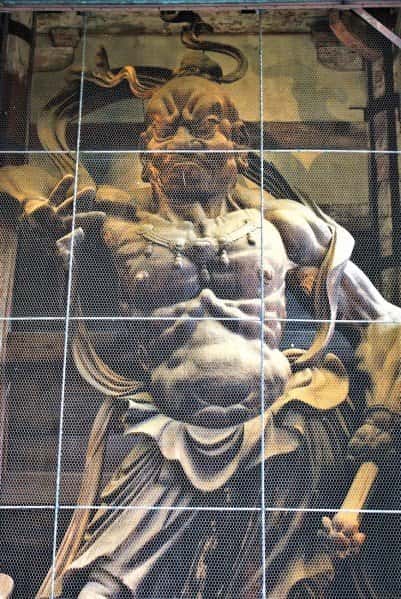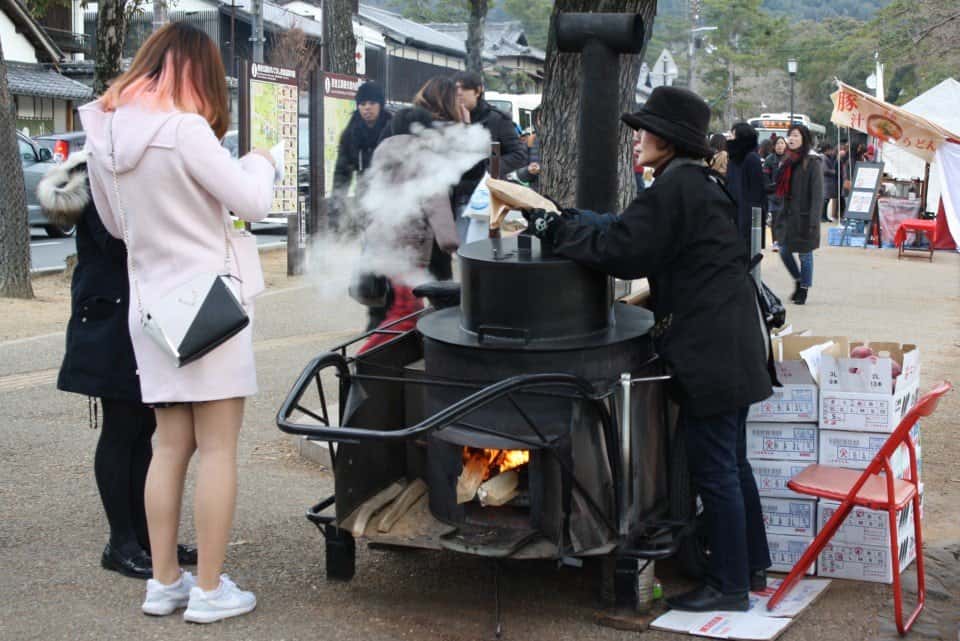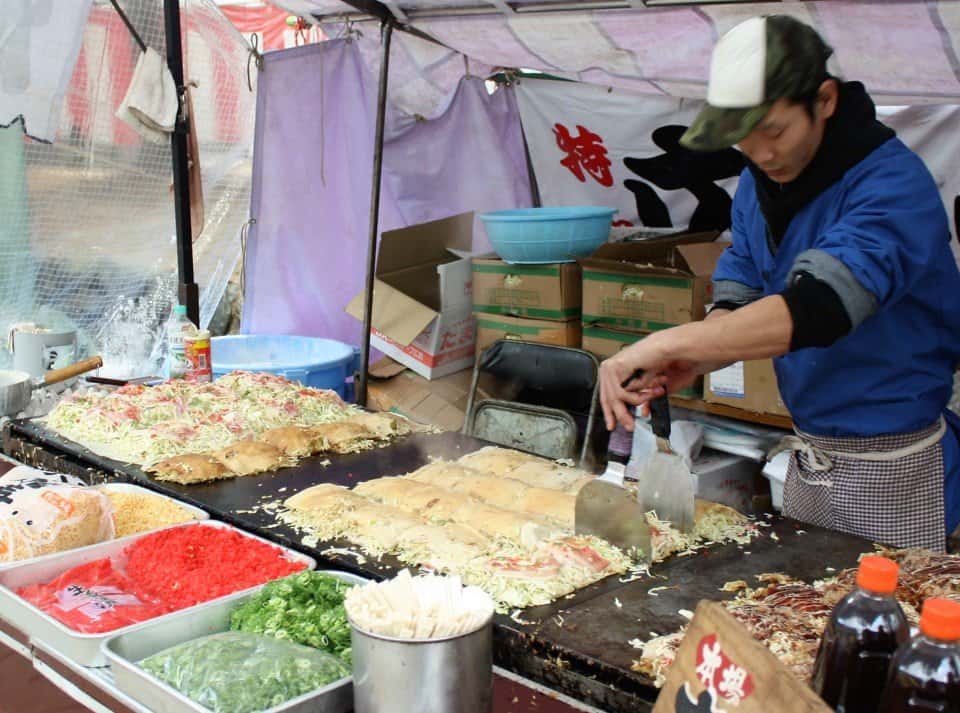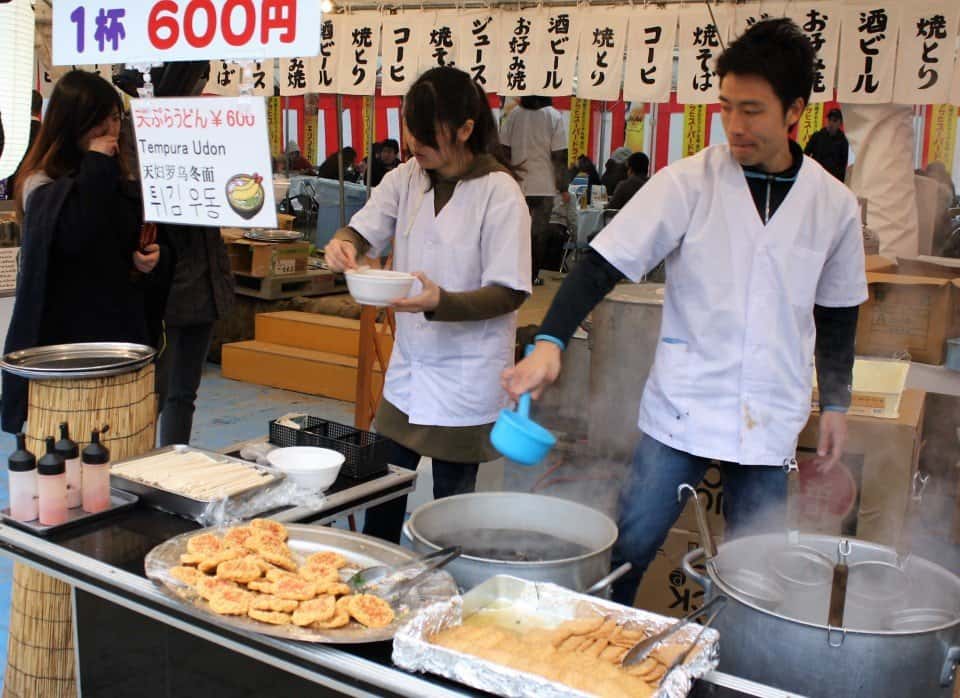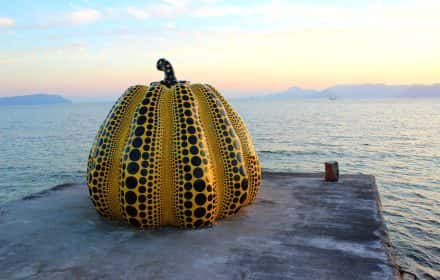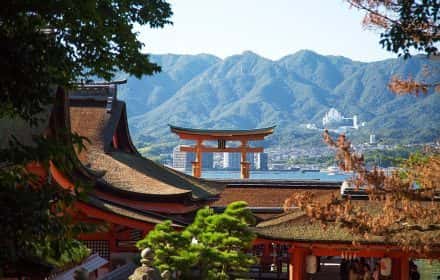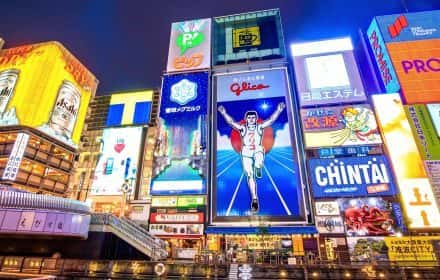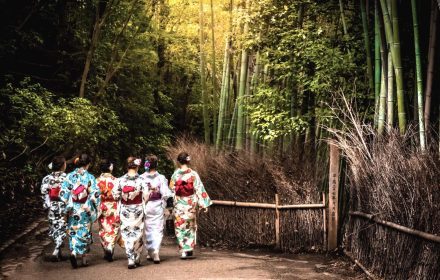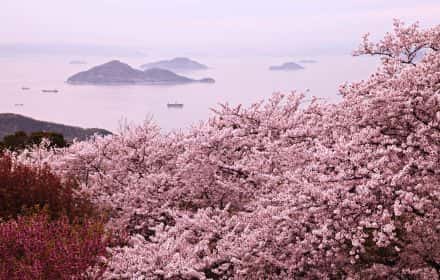This site uses affiliate links, meaning that if you make a purchase through our links, we may earn an affiliate commission.
One of the must-see sights when visiting Japan is Nara, the ancient former capital of Japan. Nara is a perfect day trip and can be easily done from either Kyoto or Osaka.
Follow this perfect one day in Nara itinerary and discover how to get to Nara and what to do and see in this top tourist attraction!
- 1. How to Get to Nara from Kyoto
- 2. How to Get to Nara from Osaka
- 3. How to Get from JR Nara Station or Kintetsu Nara Station to Nara Park
- 4. How to Get Around in Nara
- 5. What You Need to Know About Nara Before You Go
- 6. Map of One Day in Nara
- 7. One Day in Nara - 6 Things You Can't Miss
-
- 7.1. Kofukuji Temple and Five-Story Pagoda
- 7.2. Isuien Garden in Nara
- 7.3. Todaiji Temple in Nara
- 7.4. Nigatsudo Temple in Nara
- 7.5. Nara Deer Park
- 7.6. Kasuga-Taisha Temple
- 8. Where and What to Eat in Nara
- 9. Intrepid Scout's Tips for One Day in Nara
How to Get to Nara from Kyoto
Nara is a perfect destination on a day trip from Kyoto, and, there is nothing easier than to plan a day trip to Nara from Kyoto. You can do it! Here is how to get to Nara from Kyoto on a day trip: what you need to know is that there are two train lines that connect Kyoto with Nara, the JR Nara Line, and the Kintetsu Kyoto Line.
- JR Nara Line
If you have JR Pass, then you would want to take JR Nara Line. The cost of the trip will be covered by the pass. So, to start off, head to Kyoto Station and take the Miyakoji Rapid Train on the JR Nara Line. Miyakoji Rapid Train is the fastest connection between Kyoto and Nara. It only takes 45 minutes to reach JR Nara Station from Kyoto, if you take the rapid train.
I need to mention that there is Futsu local train which is covered by JR Pass as well, however, it stops by several stations on the way to Nara and the journey takes about 70 minutes.
- Kintetsu Kyoto Line
Kintetsu Kyoto Line is not covered by JR Pass, however, it is the fastest and most comfortable way to get to Nara. First of all, go to Kintetsu Kyoto Station and take the direct express (tokkyu) train on Kintetsu Kyoto Line. You will get to Kintetsu Nara Station in only 35 minutes.
By the way, JR Nara Station and Kintetsu Nara Station are within walking distance of each other and both stations are about the same distance from all the attractions.
How to Get to Nara from Osaka
If you are visiting Osaka, then, hands down, you should plan a day trip from Osaka to Nara. Tthere are two train lines connect Osaka with Nara: the JR Yamatoji Line, and the Kintetsu Nara Line.
- JR Yamatoji Line
JR Yamatoji Line is covered by Japan Rail Pass. If you have the pass, then your trip to Nara is covered. First, head to Osaka Station and take the JR Yamatoji Rapid Service. It will get you to JR Nara Station in 50 minutes.
In addition, if you are traveling from Osaka JR Namba Station, then take the local train of the Yamatoji Line to Kyuhoji Station and then transfer to the Yamatoji Rapid Service. This will get you to JR Nara Station in about 50 minutes as well.
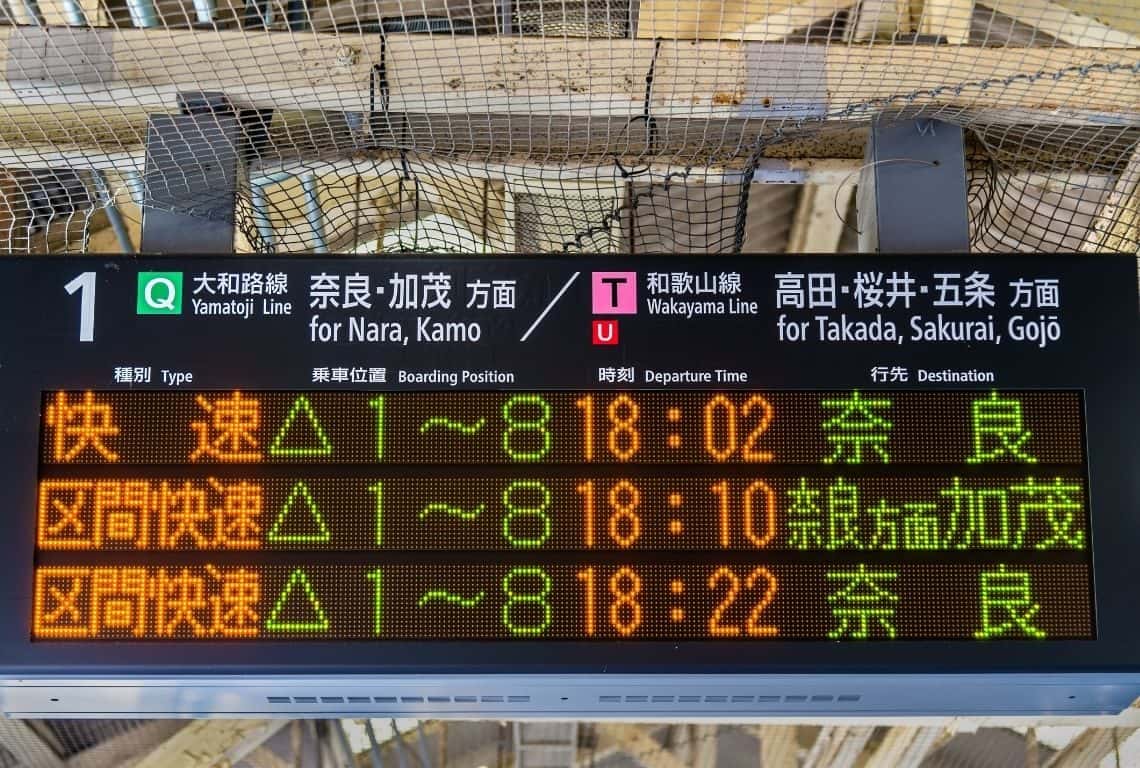
JR Yamatoji Line is covered by Japan Rail Pass. If you have the pass, then your trip to Nara is covered / One Day in Nara
One Day in Nara
- Kintetsu Nara Line
Kintetsu Nara Line is not covered by JR Pass. If you decide to take Kintetsu Nara Line, then head to Osaka Kintetsu Namba Station and take a Rapid Express train on the Kintetsu Nara Line. It will get you to Kintetsu Nara Station in about 39 minutes.
How to Get from JR Nara Station or Kintetsu Nara Station to Nara Park
As I mentioned before, JR Nara Station and Kintetsu Nara Station are located within walking distance from each other.
And, both stations are within walking distance from Nara Park where major attractions are located.
- If you are arriving at JR Nara Station then it takes about 15 minutes on foot to reach Kohfukuji Temple and the 5-Story Pagoda.
First, take East Exit from the station. Next, go north until you reach Sanjo Dori Street. It is a wide shopping street. Finally, turn right on Sanjo Dori Street (you will be walking east) and continue walking until you reach the park.
- If you are arriving at Kintetsu Nara Station then it is going to take you no more than 10 minutes on foot to reach Kohfukuji Temple and the 5-Story Pagoda. When you exit the station, turn right and then, start walking east.
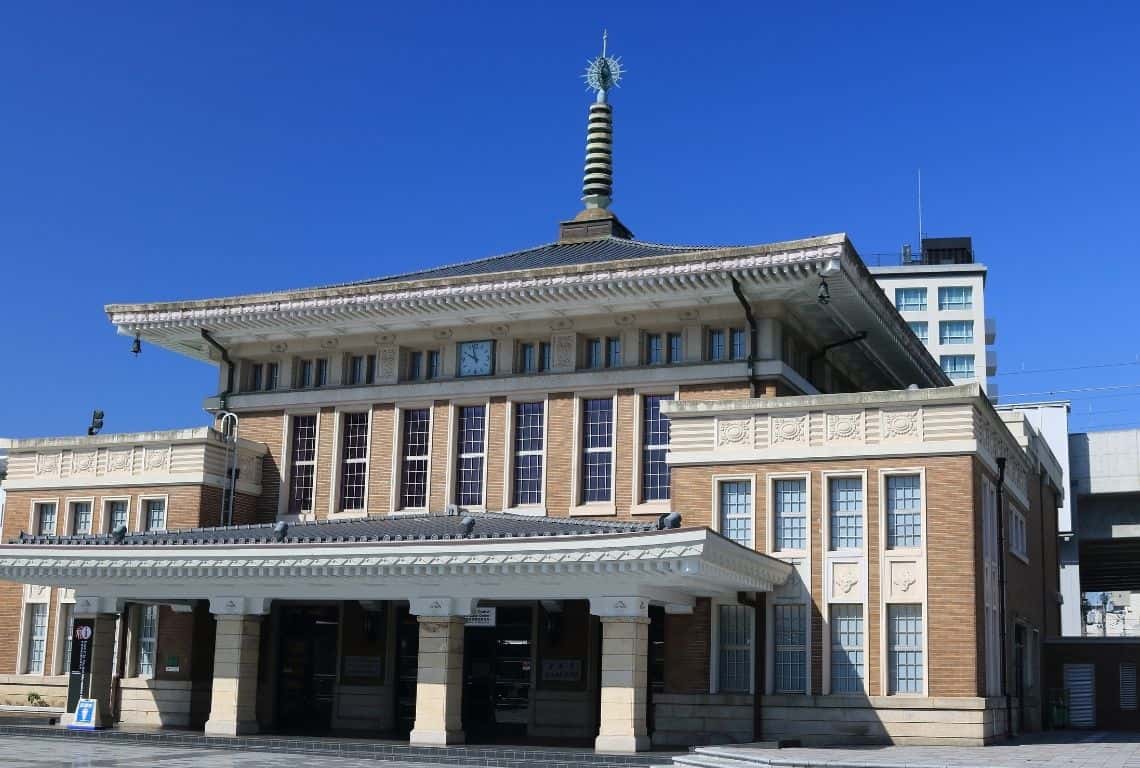
If you are arriving at JR Nara Station then it akes about 15 minutes on foot to reach Kohfukuji Temple and the 5-Story Pagoda / One Day in Nara
One Day in Nara
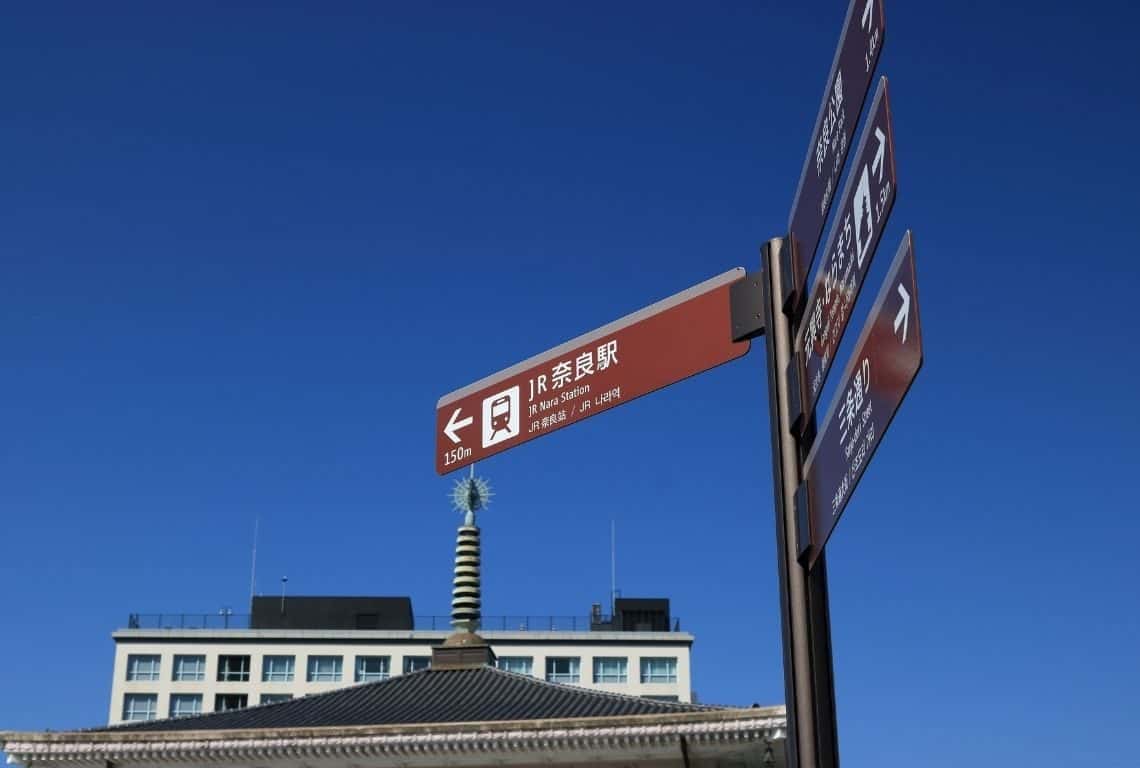
The entire area around the stations is very well-signed. So, do not worry, you will do great! / One Day in Nara
One Day in Nara
What you need to know is that there is an option to take Loop Line Bus. It is super easy! The buses are colored bright yellow!
Take the number 2 service bus from bus stop number 2. This bus will take you to Nara Park in no more than 10 minutes.
How to Get Around in Nara
There are a couple of ways to get around in Nara, you can either walk or you can take Nara Loop Line Bus.
- If the weather is good, then my recommendation is that you explore Nara Park on foot. Most of Nara’s major attractions are located within walking distance from each other. Conversely, the entire park is extremely well-signed. So do not worry, follow the signs and you will get to all of Nara’s attractions.
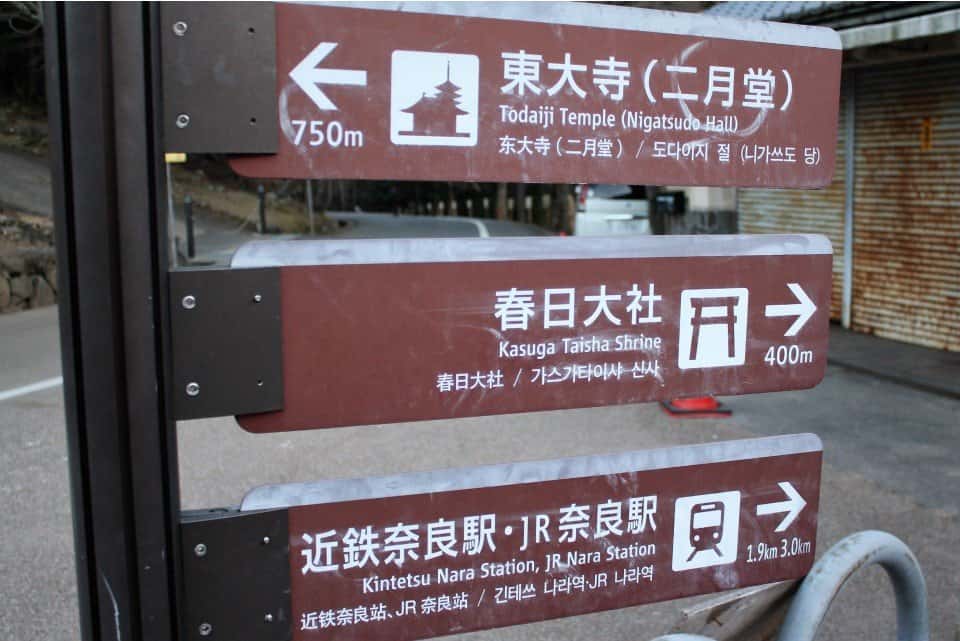
The entire Nara Park is extremely well-signed. So do not worry, follow the signs and you will get to all of Nara’s attractions / One Day in Nara
One Day in Nara
- If you do not feel like walking, then the second option is to take Nara Loop Line Bus. It is a great bus service running between the train stations and Nara Park
Number 1 Service Bus runs in a counter-clockwise direction and Number 2 Service Bus follows the same loop in a clockwise direction.
What You Need to Know About Nara Before You Go
- Did you know that until the 7th century, Japan had no permanent capital?
The capital was moved with the passing of each emperor so that his successor would not be ill-fated by the death. The practice ended under the influence of Buddhism and with the Taika reforms of 646. However, the true aim of the reforms was to bring about greater centralization and enhance the power of the imperial court.
- The official capital was finally established in 710 and Nara, which was then known as Heijōkyō, was chosen as the site.
Nara remained the capital city until 784. The period between 710 and 794 is referred to as the Nara Period in Japanese history.
Interestingly enough, when a priest by the name of Dōkyō managed to seduce an empress and nearly usurp the throne, it was decided to move the court to a new location, out of reach of Nara’s increasingly powerful clergy. This led to the new capital being established in Kyoto, where it remained until 1868.
Don't Have Time To Read One Day in Nara Now?
Why Not Save One Day in Nara to Your Pinterest Board!
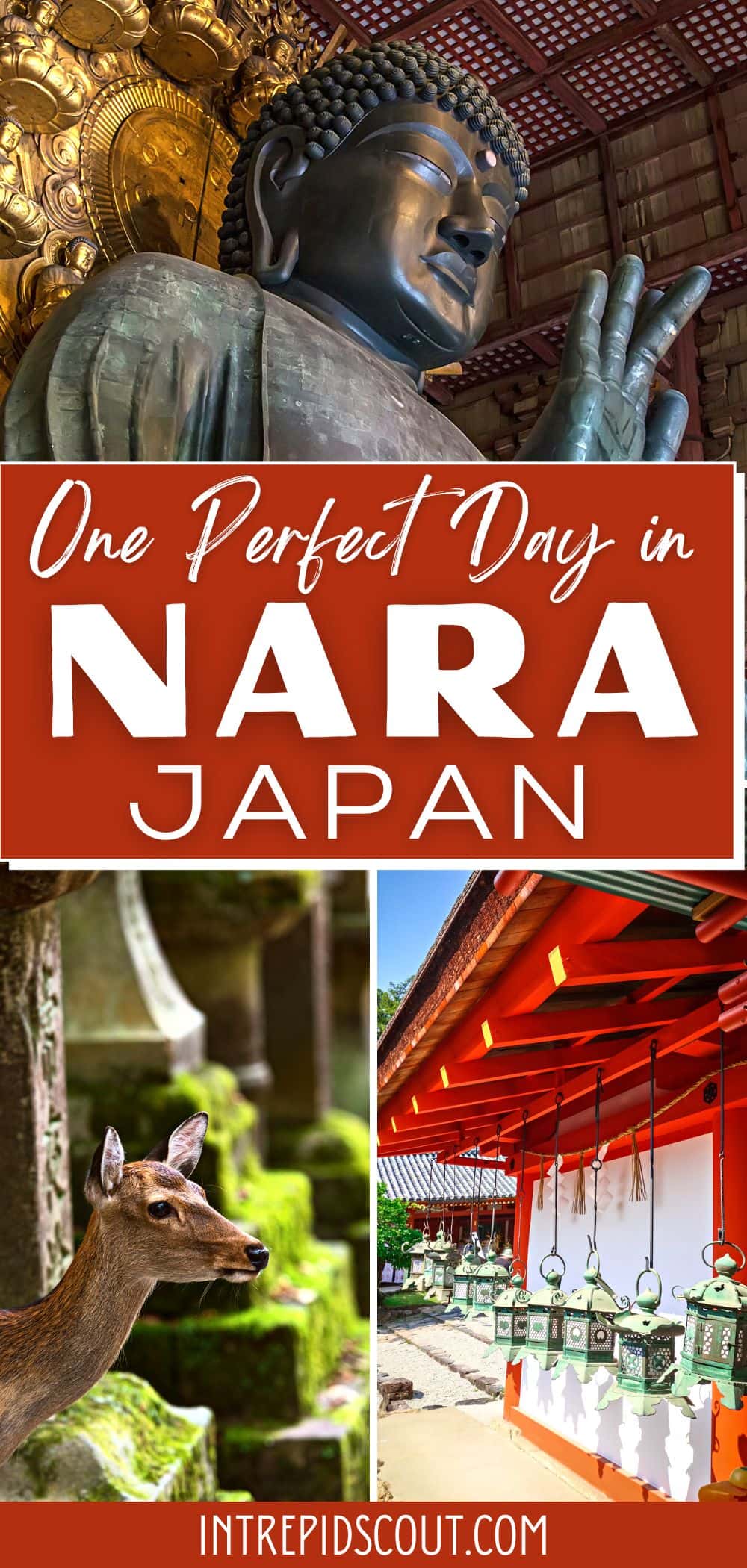
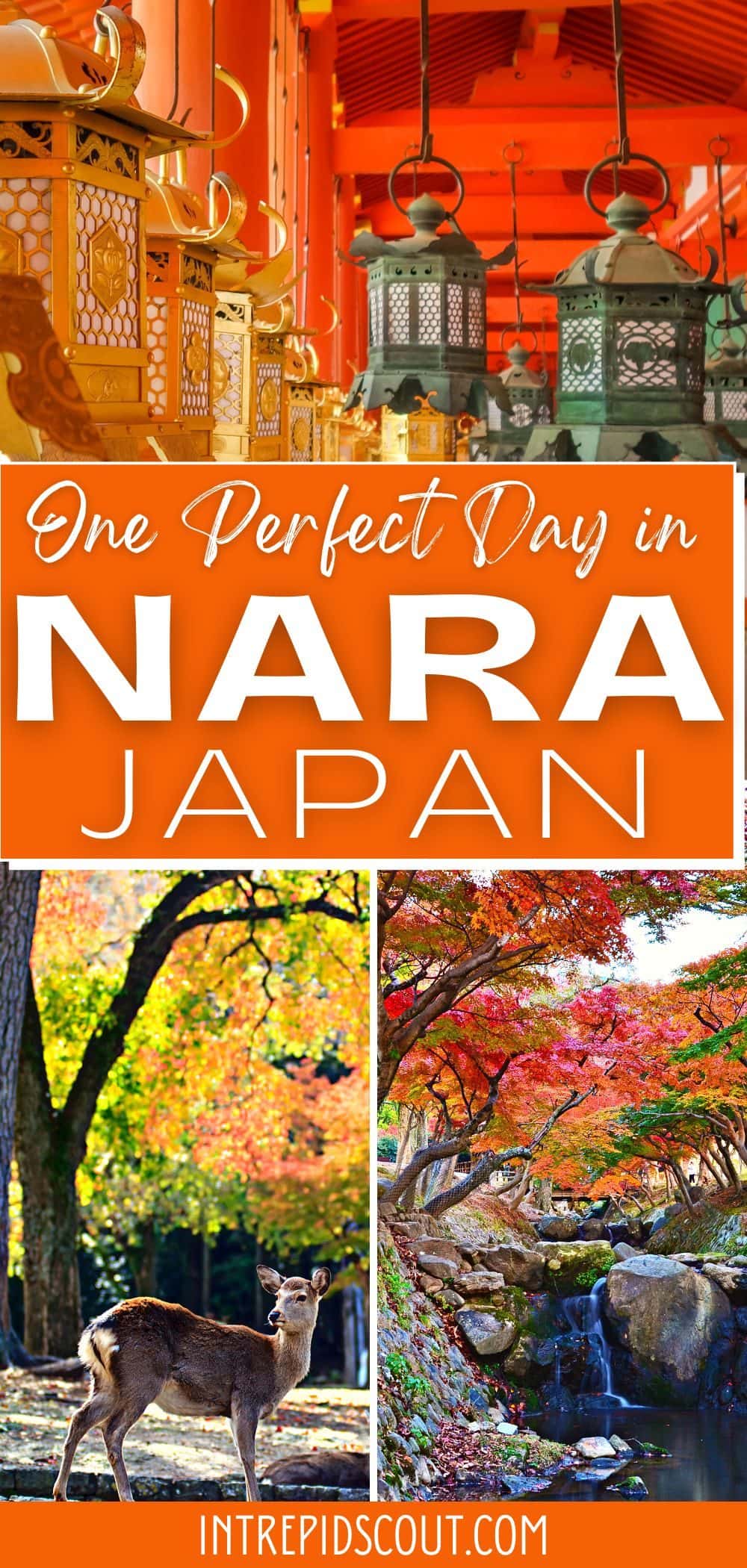
Map of One Day in Nara
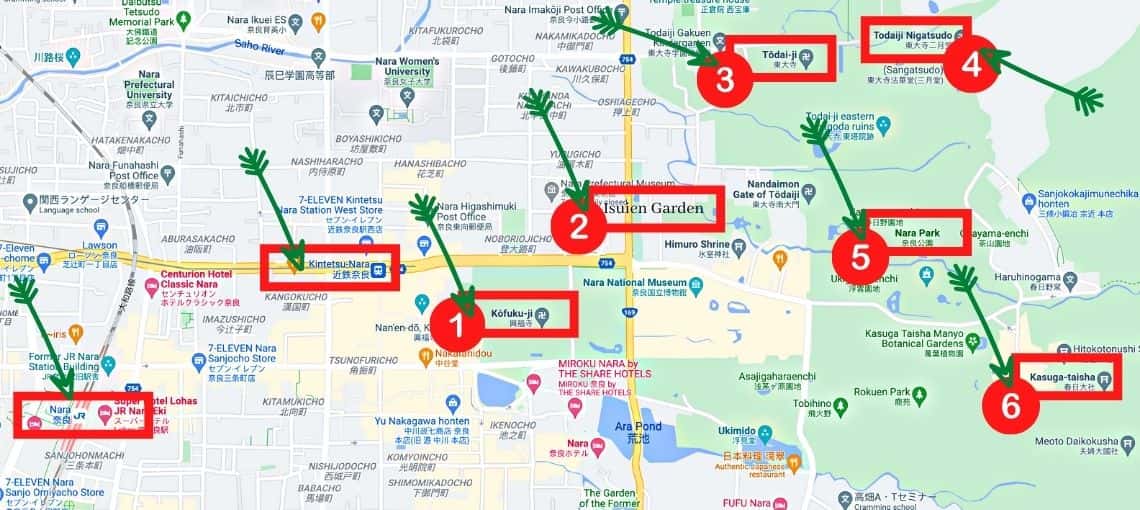
Legend: 1. Kofukuji Temple and Five-Story Pagoda, 2. Isuien Garden, 3. Todaiji Temple, 4. Nigatsudo, 5. Nara Deer Park, 6. Kasuga Taisha Temple
One Day in Nara - 6 Things You Can't Miss
Kofukuji Temple and Five-Story Pagoda
Kofuku-ji Temple was founded in 669 by Emperor Tenji when Kagami-no-Okimi, the wife of Fujiwara-no-Kamatari, prayed for her husband’s recovery from illness.
This tradition of building temples for the consort’s recovery from illness was not uncommon during that time.
Eventually, Kofukuji Temple became a family temple of the powerful Fujiwara family. Yet, it not only served religious purposes, but it also had great political power over the government.
The temple was burnt down several times through the years but it was reconstructed for the most part. In 1998, Kofukuji Temple was designated a UNESCO World Heritage Site.
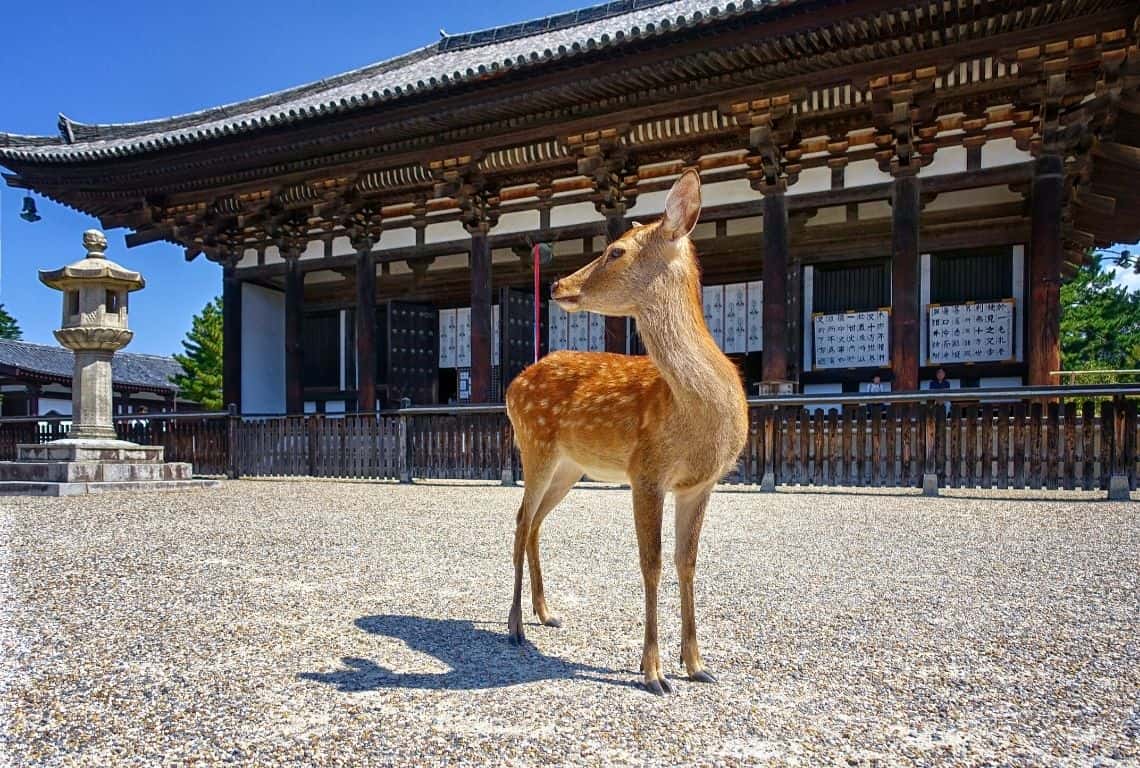
In 1998, Kofukuji Temple was designated a UNESCO World Heritage Site / One Day in Nara
One Day in Nara
The next building that will capture your attention is the five-story pagoda. The pagoda is said to have been built in 730 on the orders of Empress Komyo.
Today, Kofuku-ji Temple’s five-story pagoda is Japan’s second tallest pagoda and a symbol of Nara City.
The pagoda burnt down several times through the years. What you see today is the reconstruction from 1426.
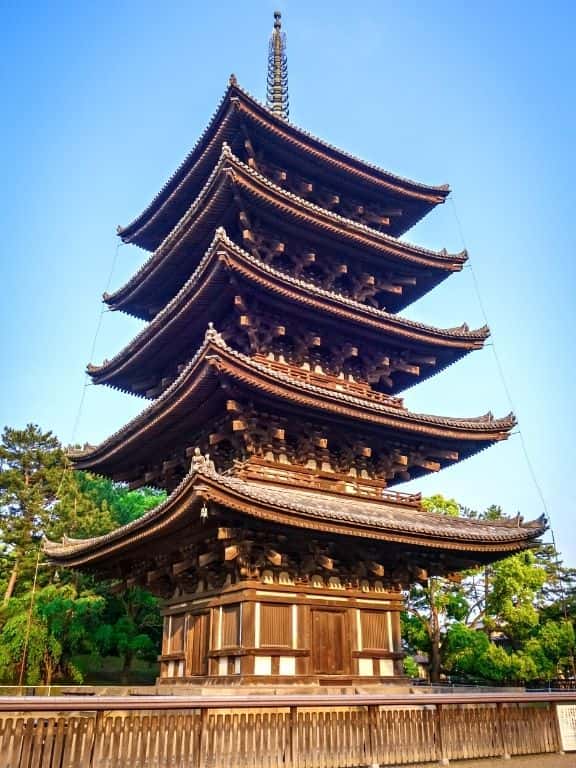
Kofuku-ji Temple’s five-story pagoda is Japan’s second tallest pagoda and a symbol of Nara City / One Day in Nara

The pagoda burnt down several times through the years. What you see today is the reconstruction from 1426 / One Day in Nara
Finally, make your way to Nanendo Hall of Kofukuji Temple. It was constructed in 813 and served as the tutelary temple of the Fujiwara clan.
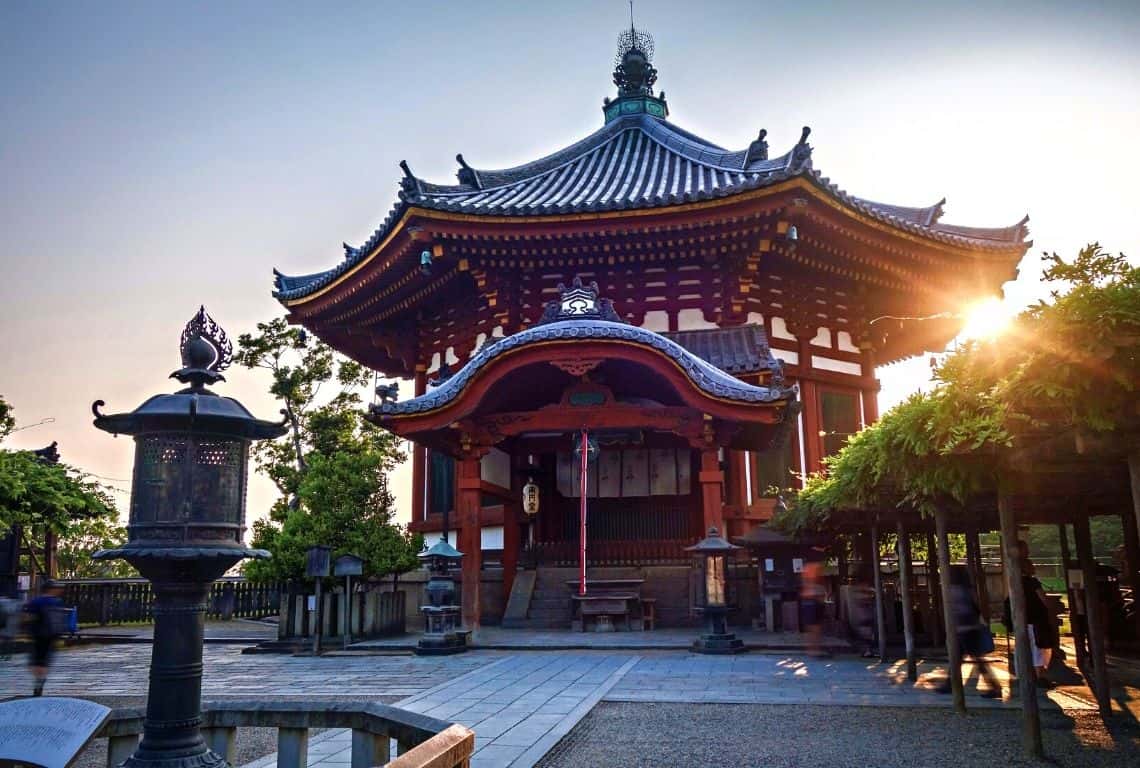
Nanendo Hall of Kofukuji Temple was constructed in 813 and served as the tutelary temple of the Fujiwara clan / One Day in Nara
One Day in Nara
Kofukuji Temple is regarded as the birthplace of Noh drama. It hosted Noh performances as far back as A.D. 869.
Today the temple hosts two major Noh events—Takigi O-noh in May and Toei-Noh in October. Both are held outdoors at night. So, if you are visiting either in May or October, then make sure to attend this classical Japanese dance-drama.
Isuien Garden in Nara
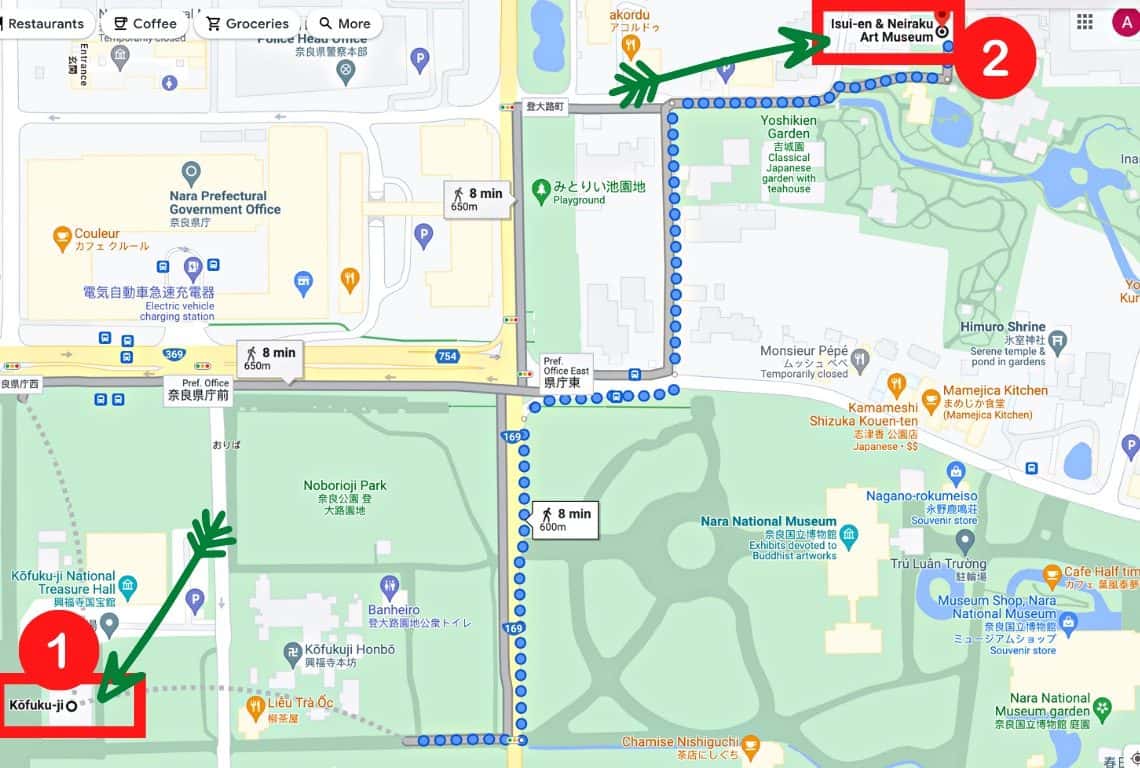
Isuien Garden in Nara / One Day in Nara
Isuien Garden has been preserved since its creation in the Meiji Era and is known for its use of borrowed scenery, such as Todaiji Temple’s Nandaimon Gate and Mount Wakakusayama.
It is divided into two sections, which were originally two separate gardens. The gardens cover roughly 145,000 square feet.
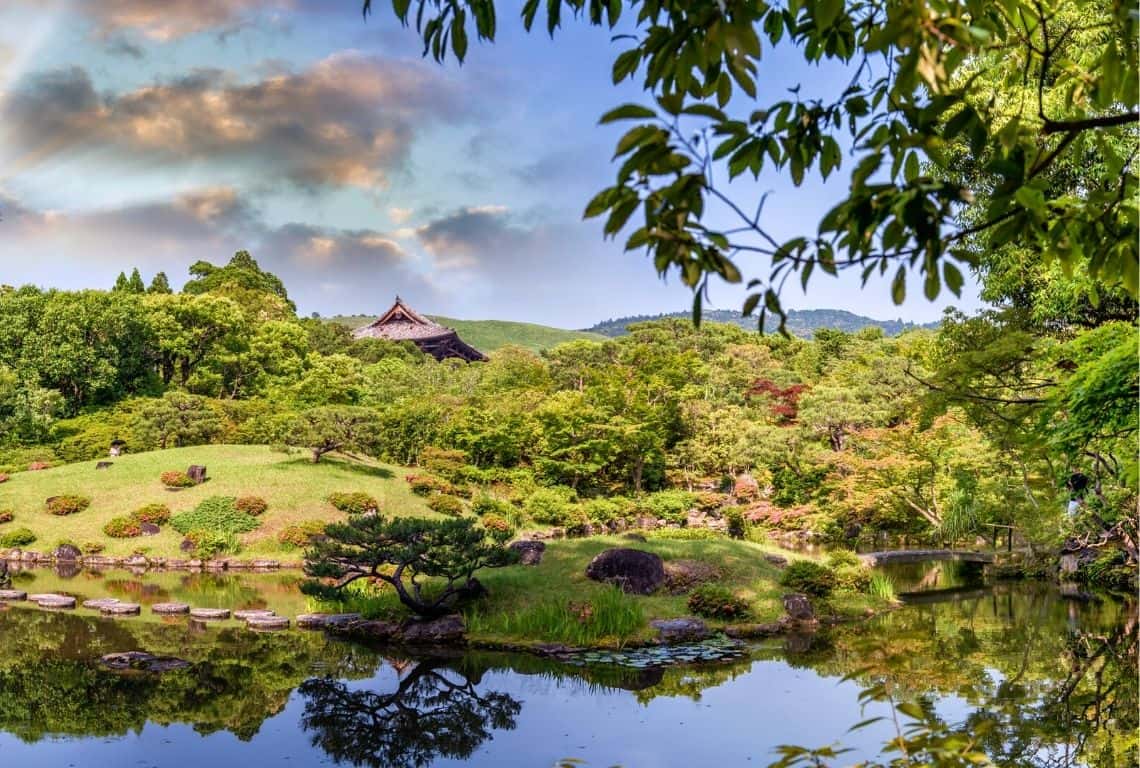
Isuien Garden has been preserved since its creation in the Meiji Era. / One Day in Nara
One Day in Nara
Isuien means garden founded on water. Its ponds are fed by the Yoshikigawa River.
In the central pond of the gardens, there are two islands with sculptures of a crane and a tortoise. In Japanese culture these animals represent longevity.
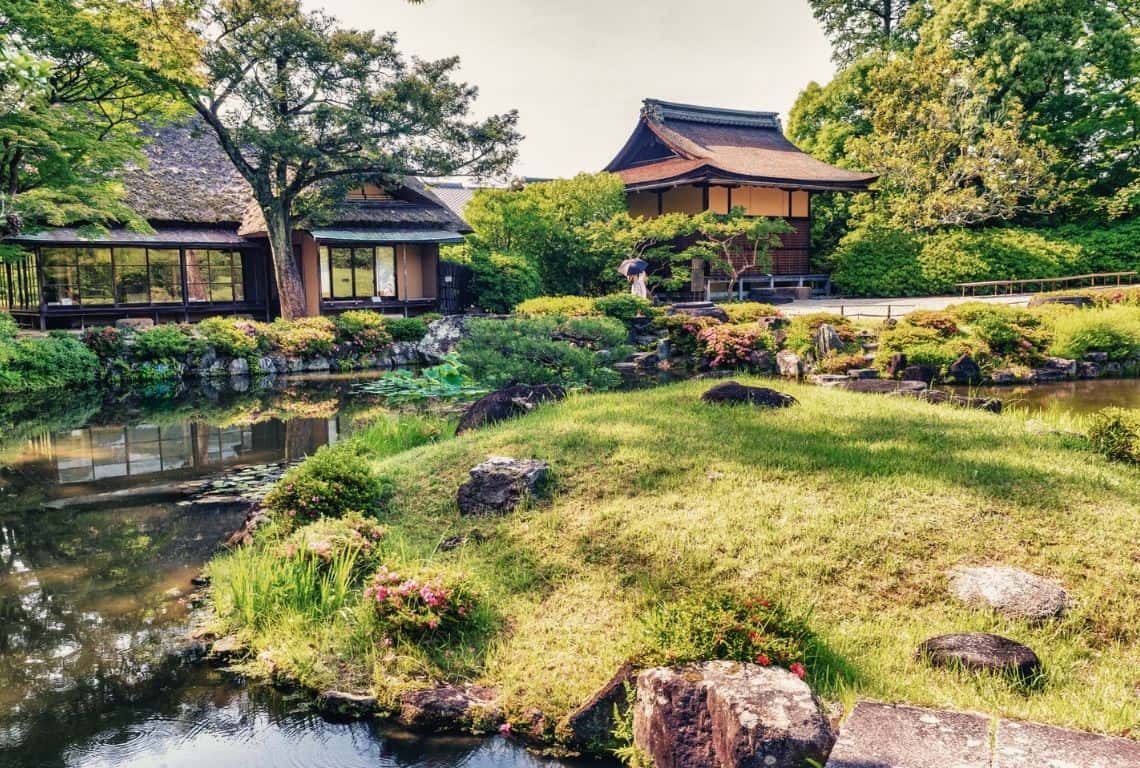
Isuien Garden is divided into two sections, which were originally two separate gardens. The gardens cover roughly 145,000 square feet (13,500 m2) / One Day in Nara
One Day in Nara
Next to Isuien Garden, you will find Yoshikien Garden. If you have time, then make sure to stop by and check it out.
Yoshikien Graden consists of three beautiful gardens: a pond garden, a moss garden, and a tea ceremony garden.
Todaiji Temple in Nara
Nara Park is home to the 8th century Todai-ji Temple (Great East Temple), the most famous of the Seven Great Temples of Nara.
For one thing, Todai-ji is the most popular site in Nara. If you can only visit one place during your Nara day trip, then Todai-ji Temple is it!
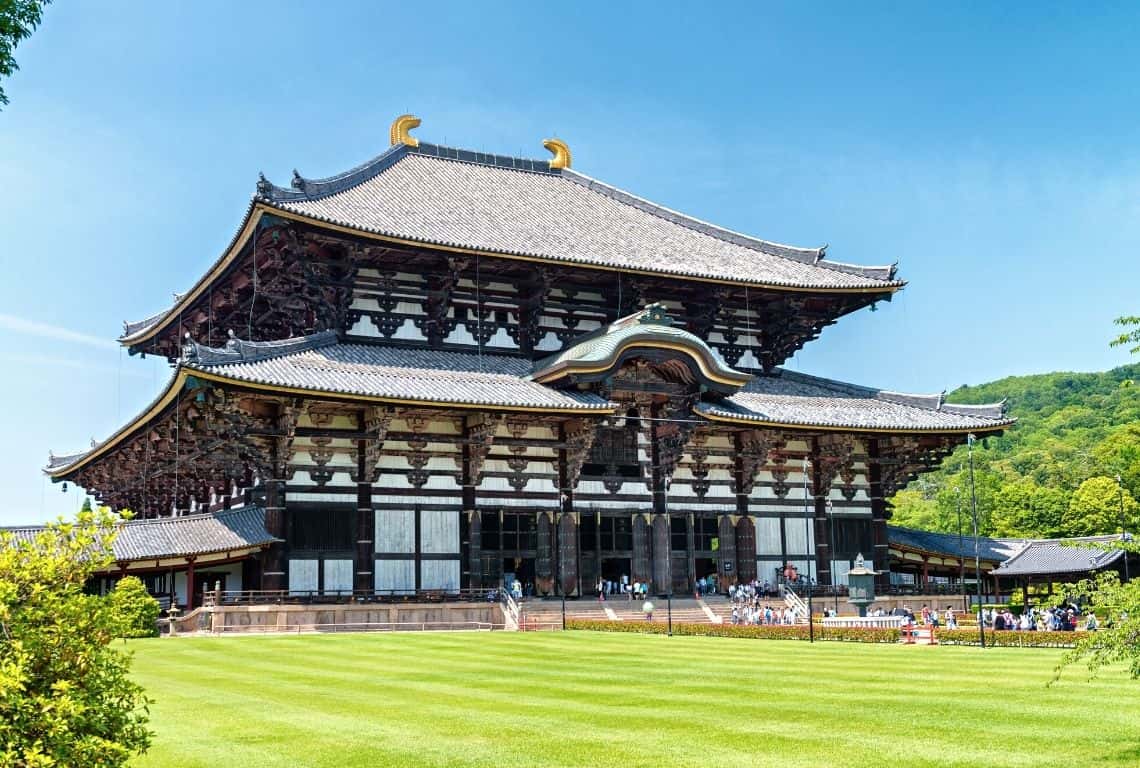
Todai-ji is the most popular site in Nara. If you can only visit one place during your Nara day trip, then Todai-ji Temple is it! / One Day in Nara
One Day in Nara
Leading to the temple is a splendid Nandaimon Gate. As you approach the gate, notice a unique plaque on top of it. It states that Todaiji is the main temple of the Kegonshu sect of Buddhism.
Next, step inside the gate. Subsequently, the gate houses two massive wooden statues. These are wrath-filled and muscular guardians of the Buddha known as Niō or Kongōrikishi. They are regarded as two of the finest wooden sculptures in Japan.
The statues were carved in the 13th century by the sculptors Unkei and Kaikei. They are about 30 feet high and particularly impressive at night when they are beautifully illuminated.

The gate houses two massive wooden statues. These are wrath-filled and muscular guardians of the Buddha known as Niō or Kongōrikishi. They are regarded as two of the finest wooden sculptures in Japan / One Day in Nara
Next, you will be greeted by an immense Todaiji Daibutsuden, which is Great Buddha Hall.
It is hard to believe that the present structure is about one-third the size of the original temple which was built by Emperor Shomu in 741.
Todai-ji Daibutsuden was destroyed several times, first in 1180 and then again in 1567. It was rebuilt in 1709.
Also, did you know that Todai-ji Daibutsuden is the world’s largest wooden structure? Notwithstanding, it is a masterpiece! Notably, many of the crisscrossing beams are positioned without any nails.
Todai-ji Daibutsuden houses the world’s largest bronze Buddha (Daibutsusan). The great Buddha of Nara was originally constructed between 735 and 749. It is 49.1 feet high and weighs over 550 tons.
When the giant Buddha was constructed, all of Japan’s reserves of bronze and precious metals were used up!
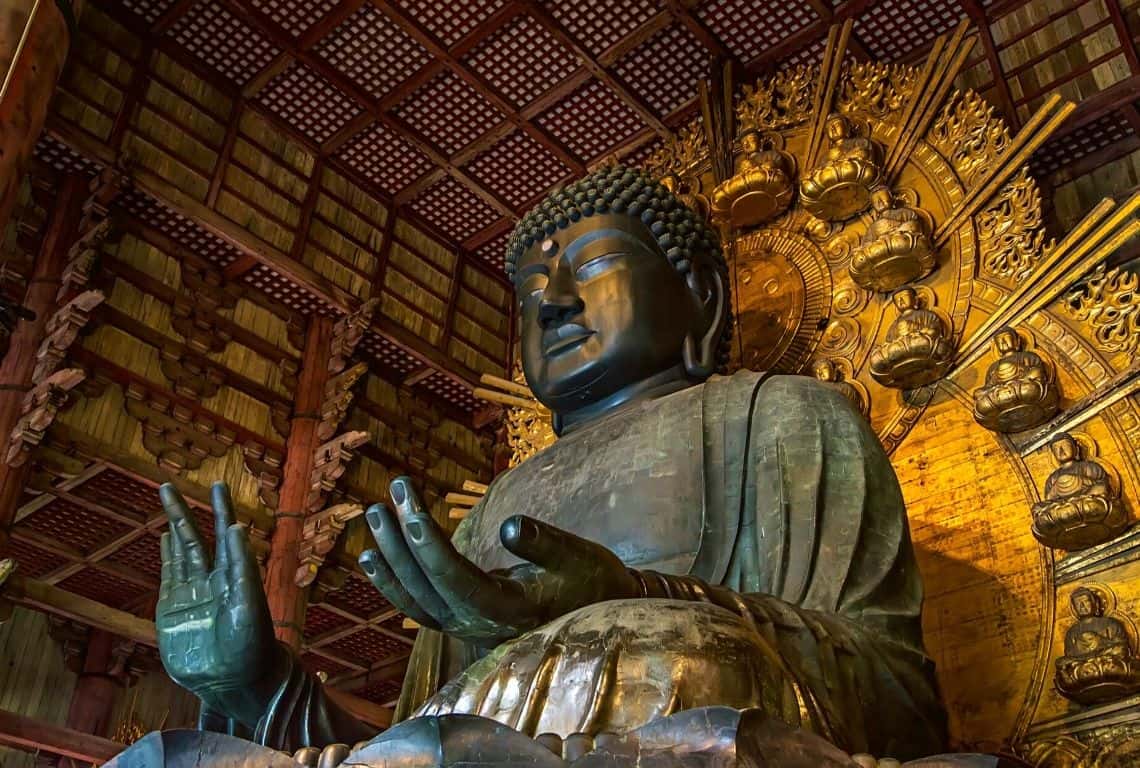
Todai-ji Daibutsuden houses the world’s largest bronze Buddha (Daibutsusan). The great Buddha of Nara was originally constructed between 735 and 749. It is 49.1 feet high and weighs over 550 tons / One Day in Nara
One Day in Nara
The great Buddha of Nara is flanked by two Bodhisattvas.
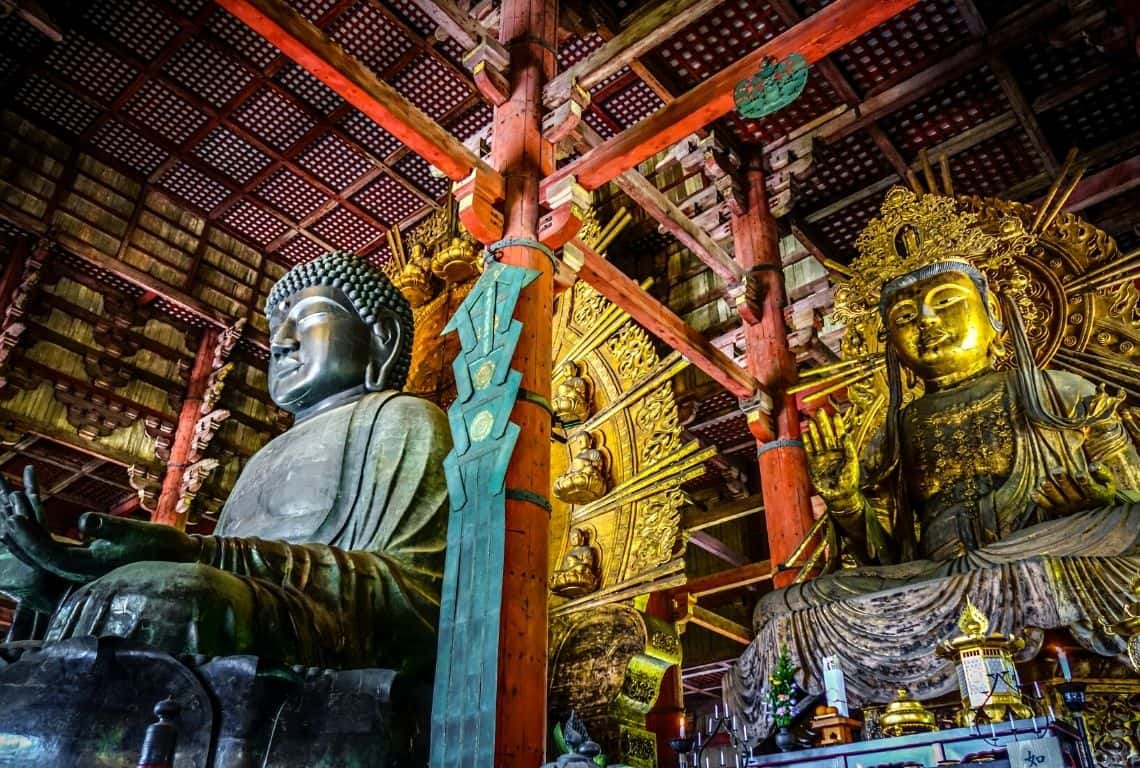
The great Buddha of Nara is flanked by two Bodhisattvas / One Day in Nara
One Day in Nara
In addition to the Great Buddha of Nara, there are towering 30-foot-high wooden statues of warriors.
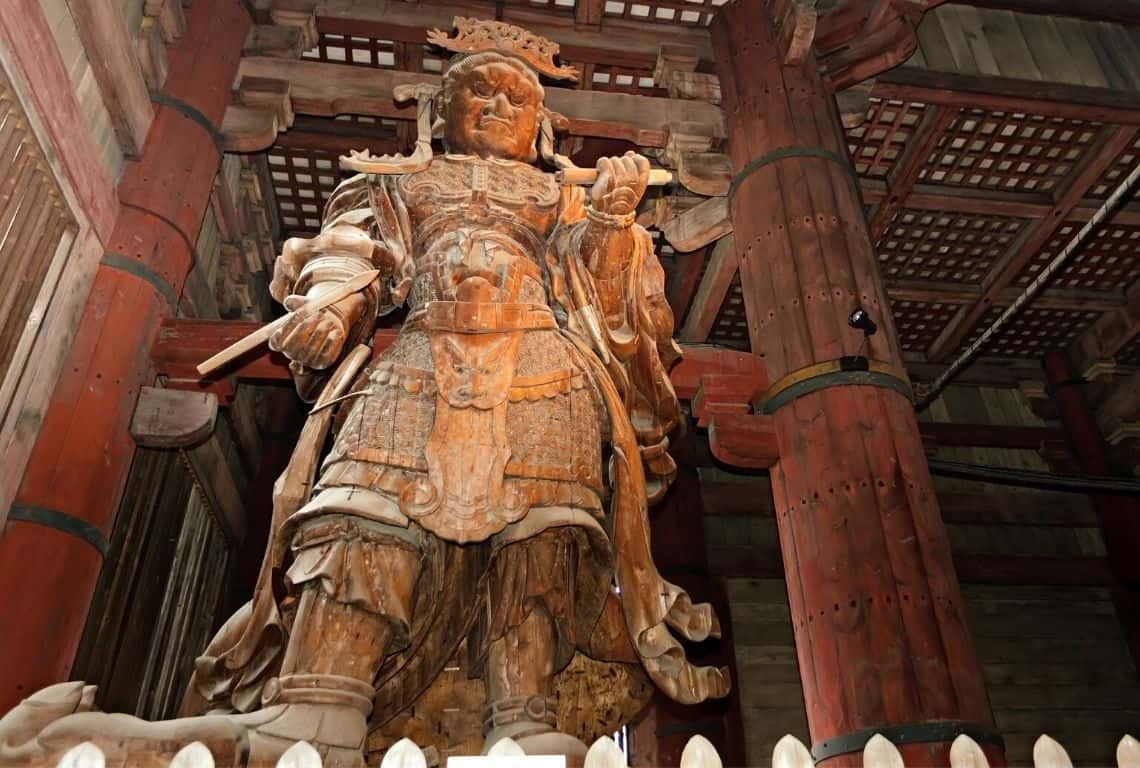
Impressive wooden statues of warriors / One Day in Nara
One Day in Nara
Another popular attraction inside Todai-ji is a pillar with a hole in its base. Notably, the hole in the pillar is about the same size as Daibutsusan’s nostril.
It is said that those who can squeeze through this opening will receive enlightenment in their next life and also have all their prayers answered.
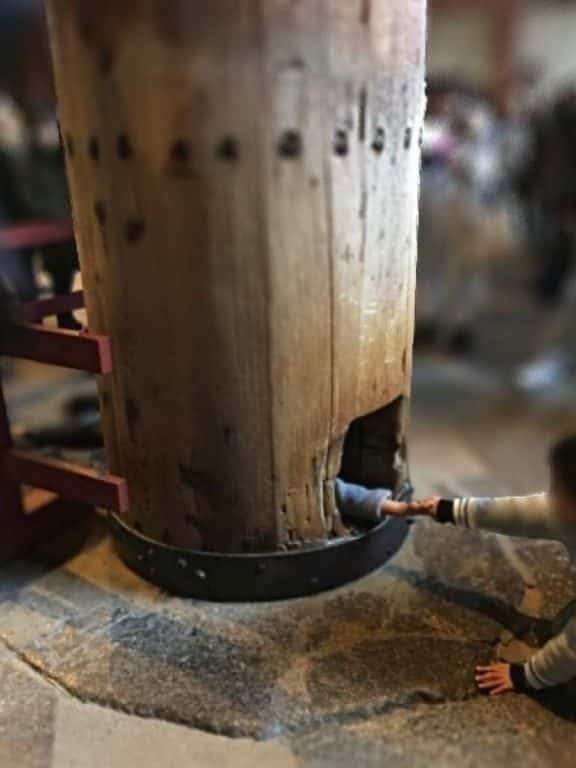
Another popular attraction inside Todai-ji is a pillar with a hole in its base / One Day in Nara
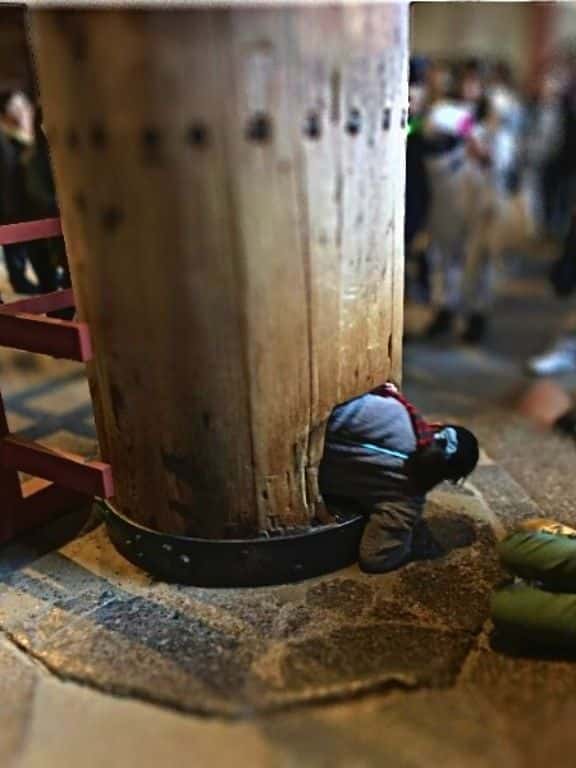
It is said that those who can squeeze through this opening will receive enlightenment in their next life and also have all their prayers answered / One Day in Nara
Todaiji Temple is open daily from 7:30 am till 5:30 pm (April to October) and 8 am to 5 pm (November to March). Admission is 600 yen.
Make sure to buy a combination pass, which is a better deal and includes the Great Buddha Hall and Todaiji Museum. It costs 1,000 yen.
Nigatsudo Temple in Nara
To the east of the Great Buddha Hall and up on the side of Mount Wakakusa overlooking the city of Nara, sits Nigatsu-do, the Hall of the Second Month.
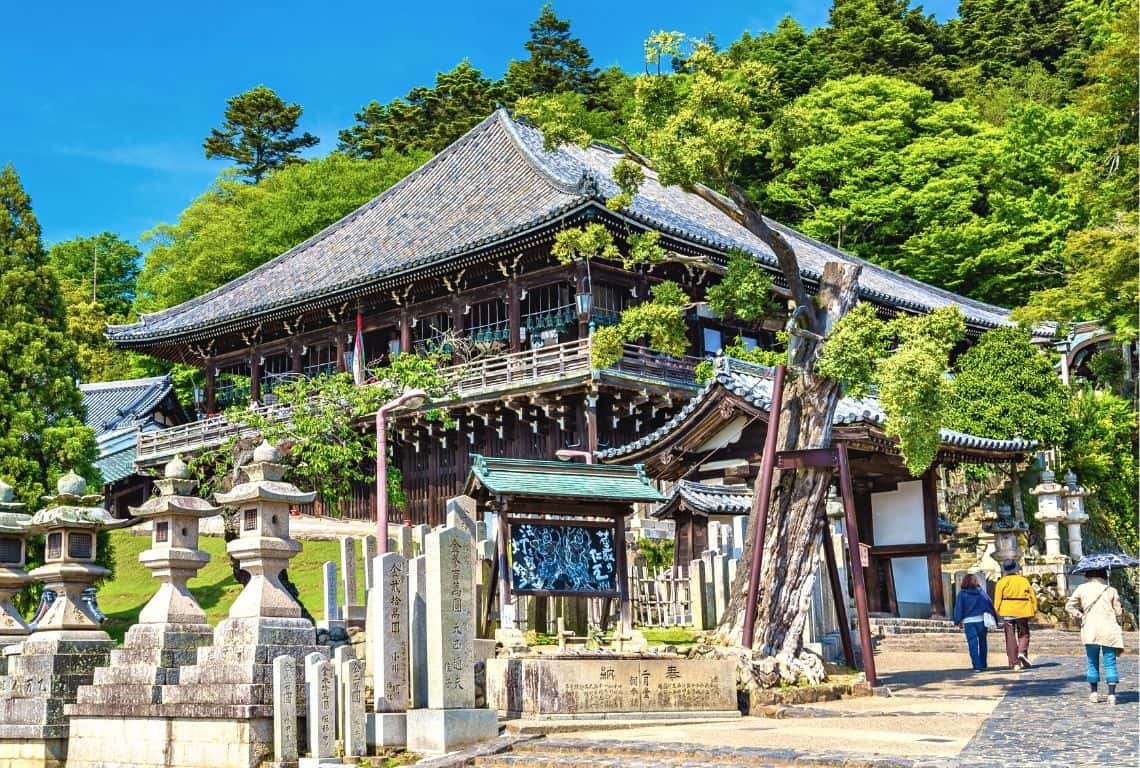
To the east of the Great Buddha Hall, you will find Nigatsudo Temple / One Day in Nara
One Day in Nara
I think you will immediately notice that the atmosphere here differs from other temples in Nara. It may lack the grandeur of the Great Buddha Hall, but it has many intriguing elements and beautiful masterpieces.
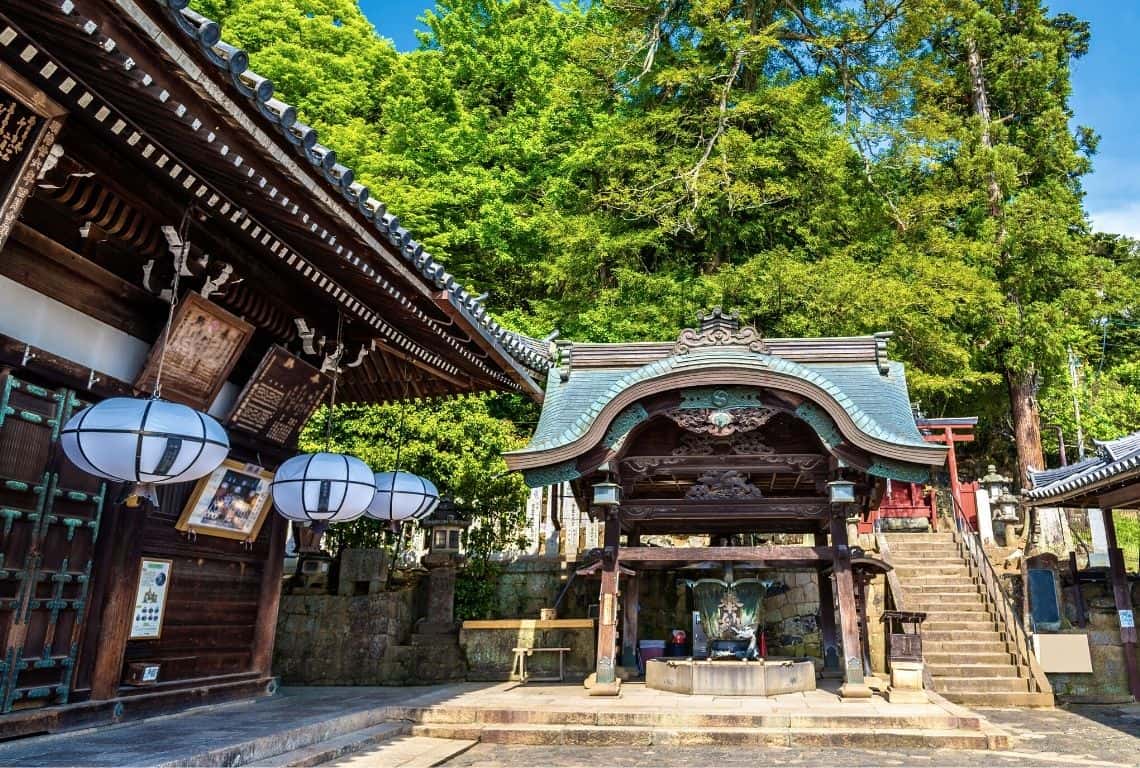
Nigatsudo Temple has many intriguing elements and beautiful masterpieces / One Day in Nara
One Day in Nara
What caught my attention was the 18th-century Pindola divinity wooden statue. It is a Buddha disciple master in occult powers. It is believed that if you rub some part of his body and then you rub the same part of your body, the sickness or illness will leave your body.
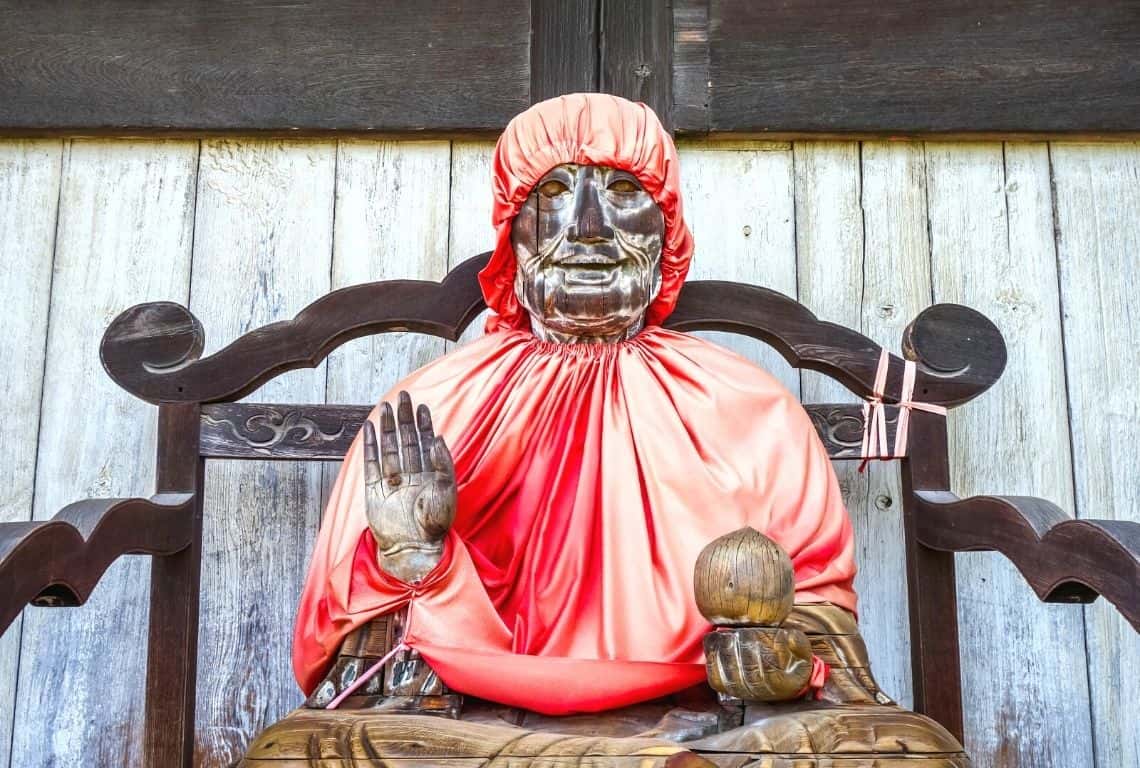
18th-century Pindola divinity wooden statue. It is a Buddha disciple master in occult powers / One Day in Nara
One Day in Nara
By the way, the name Nigatsudo means the Hall of the Second Month or February Hall. It is derived from the fact that the Shuni-e Ceremony is held here during the second month of the lunar calendar. The Shuni-e Ceremony is also known as the Omizutori Festival.
The Omizutori Festival is marked with an eye-catching display of massive torches (6-8 meters in size).
The torches are carried up to Nigatsudo Hall’s balcony and then held above the Nigatsudo courtyard. These blazing torches shower down embers over the audience. This showering of sparks is believed to bestow a safe and fruitful year upon the gathered crowd.
What I liked about Nigatsudo Temple was the large front platform where you will get rewarded with the most spectacular view of Nara. My recommendation is to come back to Nigatsu-do Temple and catch a spectacular sunset!
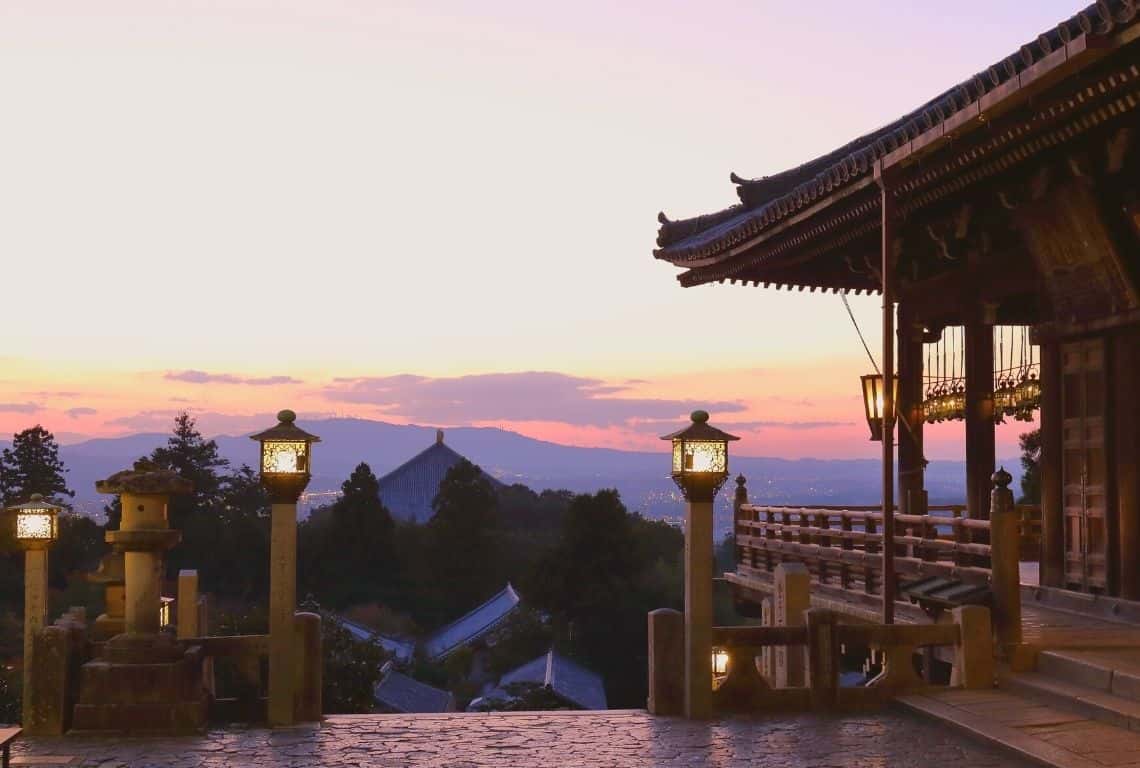
My recommendation is to come back to Nigatsu-do Temple and catch a spectacular sunset / One Day in Nara
One Day in Nara
Nara Deer Park
Nara is famous for its temples and shrines, however, on your Nara day trip you simply cannot skip the free-roaming Nara deer. They are just as popular!
By the way, there are hundreds of deer wandering through the vast lawns of Nara Park. Honestly, I thought that it would be rather hard to find them, when in fact, they are everywhere.
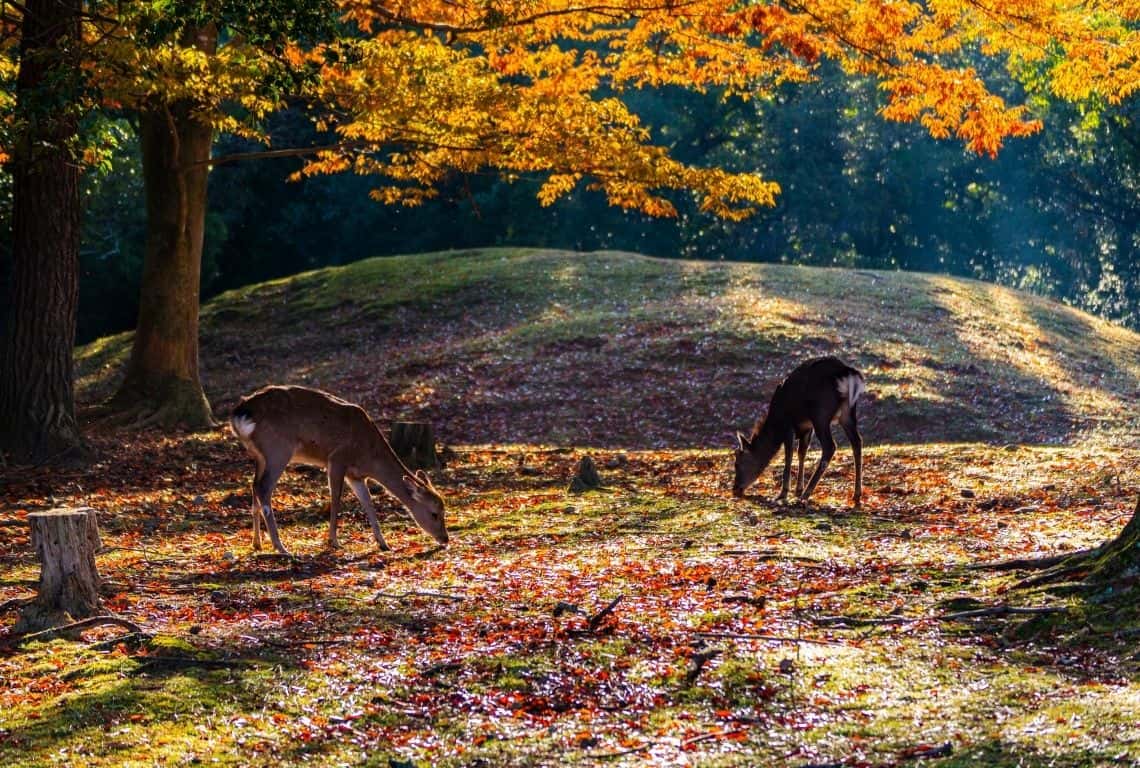
By the way, there are hundreds of deer wandering through the vast lawns of Nara Park. / One Day in Nara
One Day in Nara
I found them to be friendly, and curious and show great interest in rice bran crackers called shika sembei – rice biscuits.
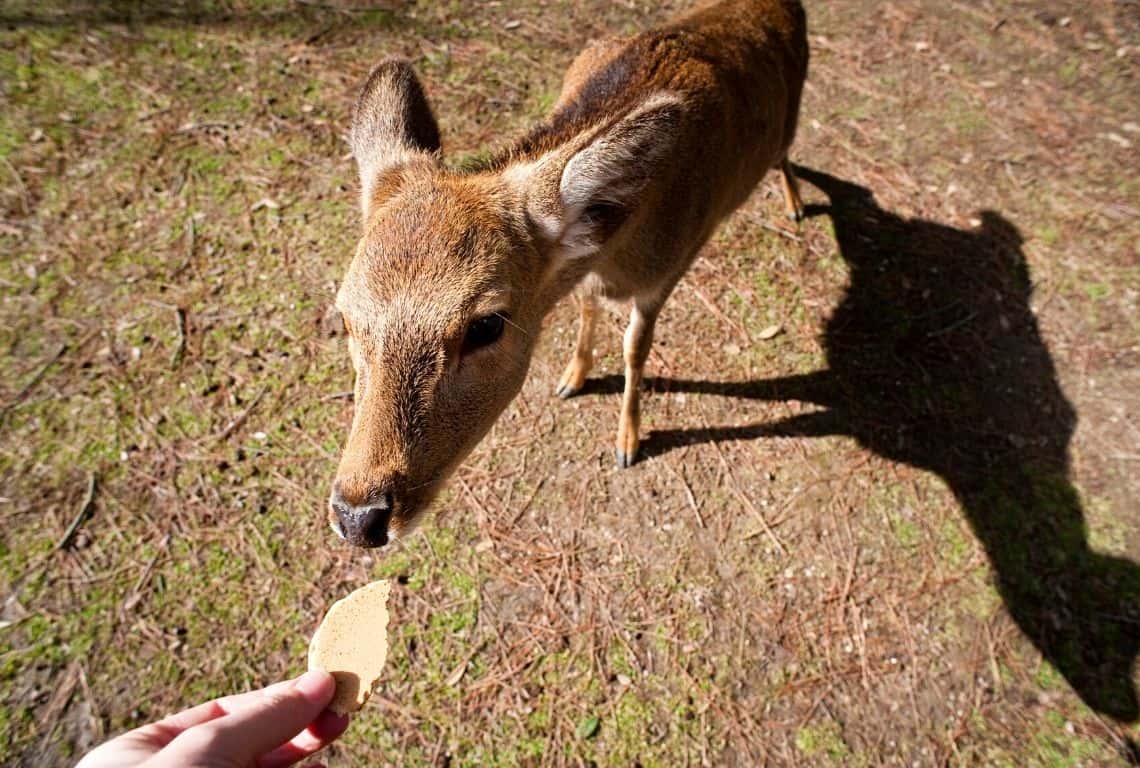
They show great interest in rice bran crackers called shika sembei – rice biscuits / One Day in Nara
One Day in Nara
Apparently, there are over 1,300 deer in Nara Park. These deer are called sika, which is derived from the Japanese word for deer: shika.
Legend has it that in 768 when the Fujiwara family established the great Kasuga Shrine in the foothills of the Wakakusa Mountain, a Shinto deity descended from the mountain to the new sanctuary riding a sacred white deer. Since then, the deer became a revered animal, protected by the authorities, and a symbol of the city.
Interestingly enough, until 1637, killing a deer in Nara was considered a serious crime, even punishable by the death penalty.
After WWII the divinity of deer was officially suspended, but they were declared a national treasure. Nowadays, they are protected and maintained in a semi-wild state which humans and deer use to mutual advantage.
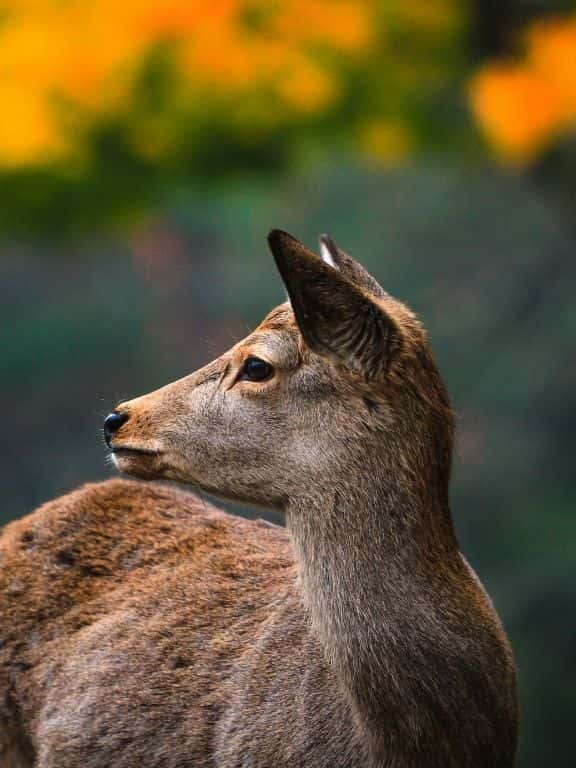
Apparently, there are over 1,300 deer in Nara Park / One Day in Nara
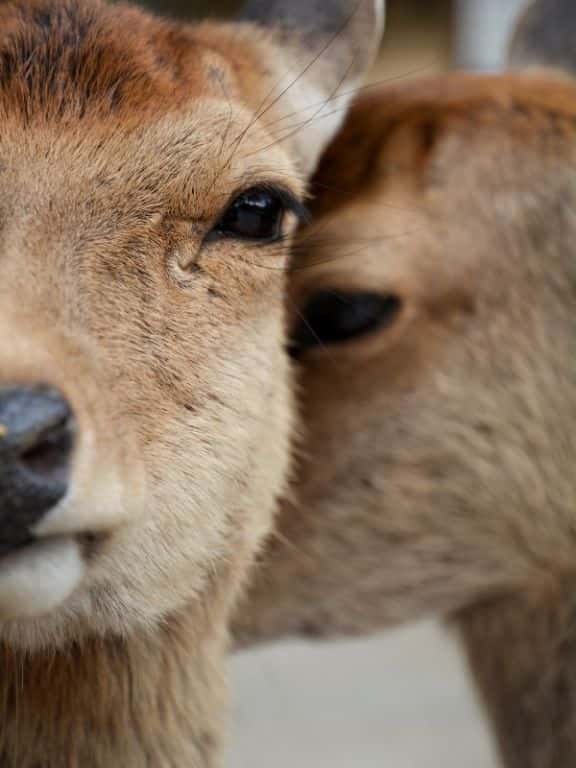
These deer are called sika, which is derived from the Japanese word for deer: shika / One Day in Nara
Kasuga-Taisha Temple
I have to honestly say that I love Nara and all the beautiful places in Nara, but Kasuga Taisha Shrine is my favorite place in Nara. Kasuga Taisha Shrine is top-notch!!!
The path leading to Kasuga Taisha Shrine is stunning. It is lined with thousands of aged, moss-covered stone lanterns.
The stone lanterns are known as “toro” and have been donated by worshipers as an expression of their faith.
And, be on the lookout for the deer peeking in between the lanterns!
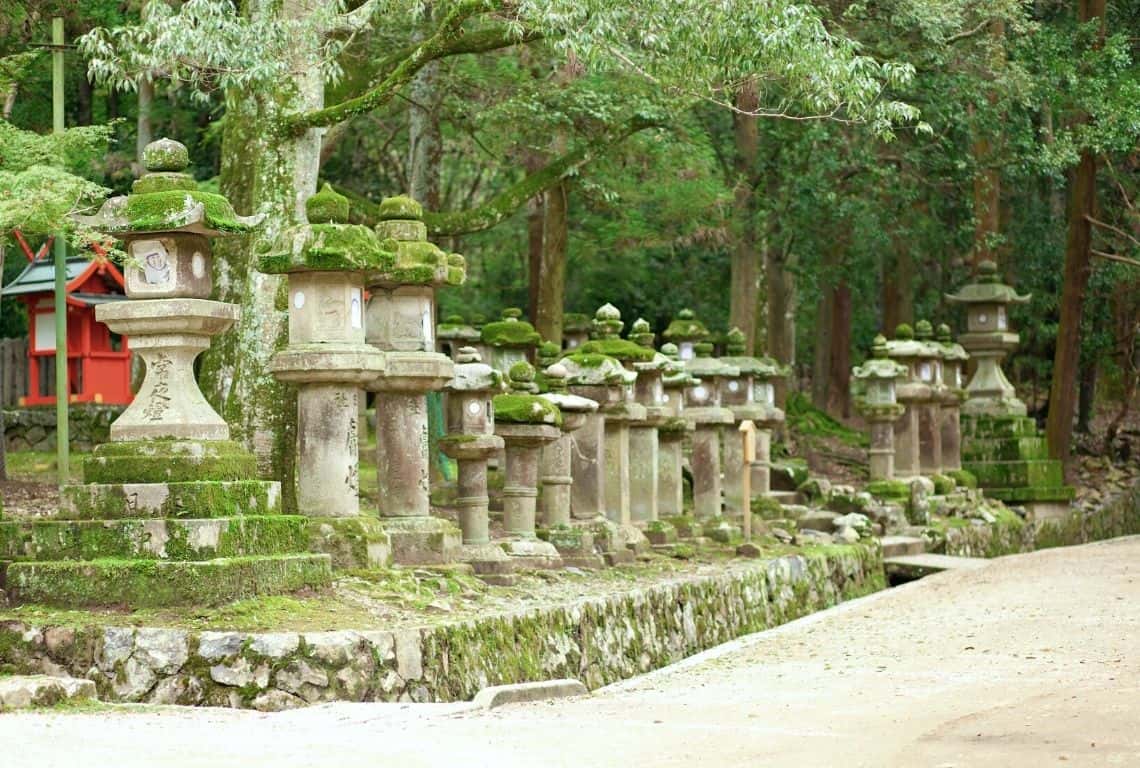
The path leading to Kasuga Taisha Shrine is stunning. It is lined with thousands of aged, moss-covered stone lanterns / One Day in Nara
One Day in Nara
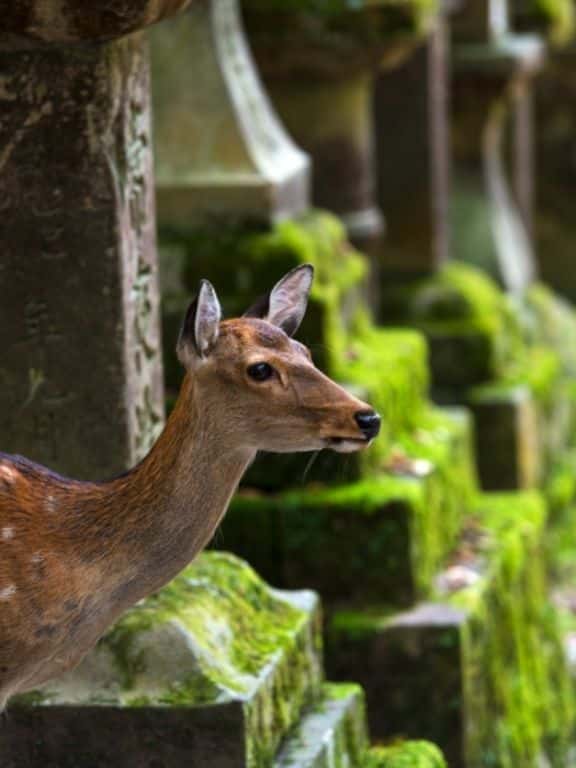
Be on the look-out for the deer peeking in-between the lanterns / One Day in Nara
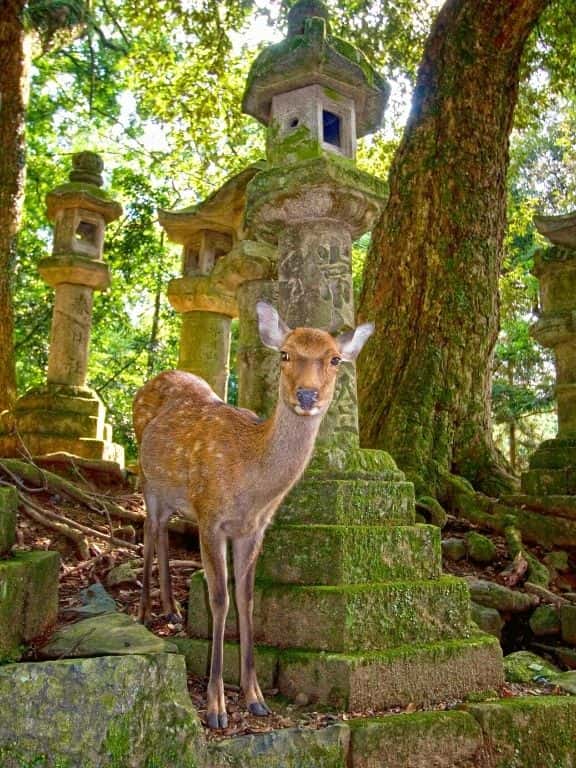
Be on the look-out for the deer peeking in-between the lanterns / One Day in Nara
The path will eventually lead you to the vermilion-colored Kasuga Taisha Shrine.
The eves of the shrine are decorated with thousands of hanging brass and bronze lanterns; some new and brightly polished, some old and tarnished by time.
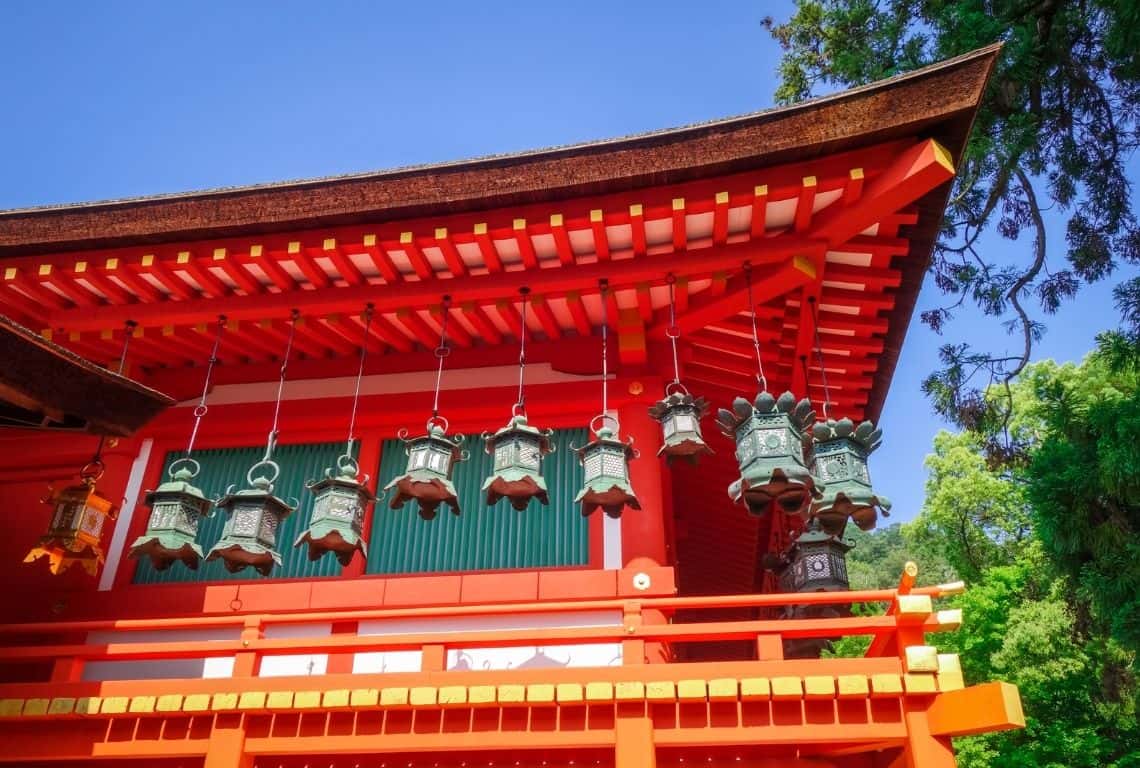
The eves of Kasuga Taisha Shrine are decorated with thousands of hanging brass and bronze lanterns / One Day in Nara
One Day in Nara
Kasuga Taisha is Nara’s most celebrated shrine.
The origins of Kasuga Taisha Shrine date back to the year 768, when four deities: Takemikazuchi-no-mikoto, Futsunushi-no-mikoto, Amenokoyane-no-mikoto and his consort Himegami were enshrined here for the prosperity and protection of the nation and the happiness of the citizens.
These four deities are also known as Kasuga-sume-ookami or Kasuga-Daimyojin (the Great Deities of Kasuga).
It is believed that the original designation of the site as a place of Shinto worship dates back to 710. Moreover, Kasuga Taisha Shrine was designated as a UNESCO World Heritage Site in 1998.
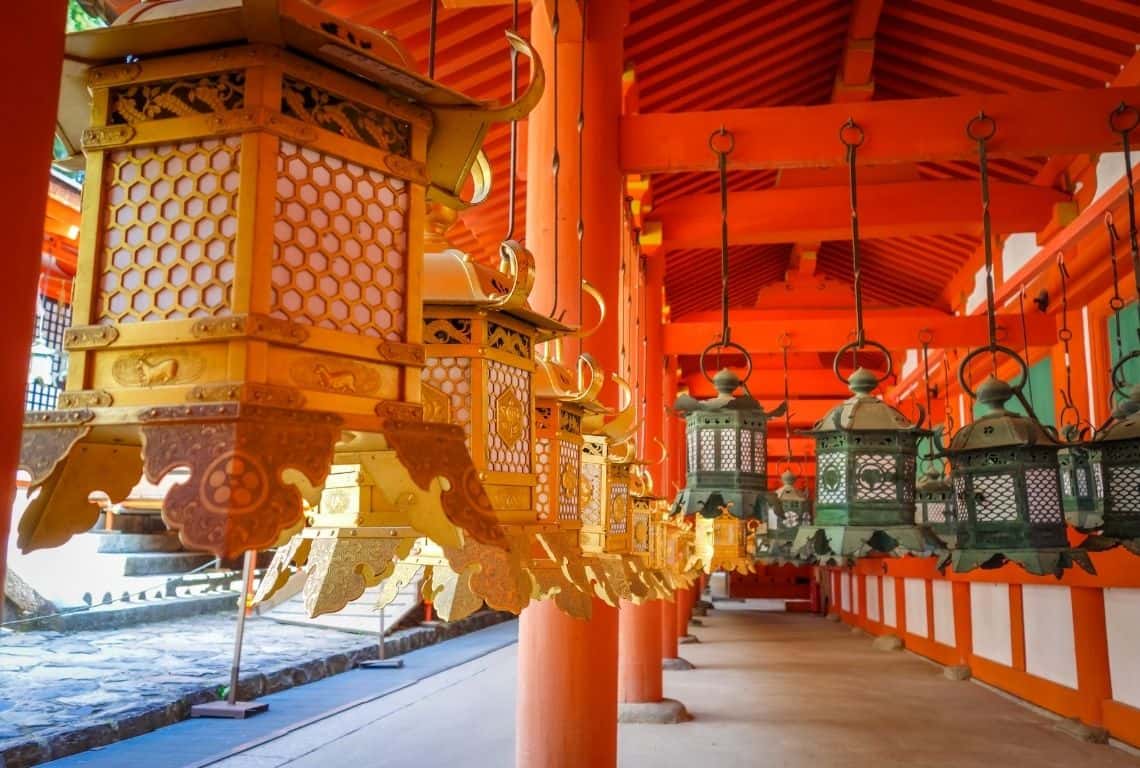
Kasuga Taisha is Nara’s most celebrated shrine / One Day in Nara
One Day in Nara
The complex is open every day. Entrance to the grounds is free of charge except for a paid inner area (500 yen) which allows a closer view of several buildings with bronze lanterns and the Main Worship Hall.
If possible, come back to Kasuga Taisha Shrine in the evening. Notwithstanding, the entire place is absolutely stunning in the evening!
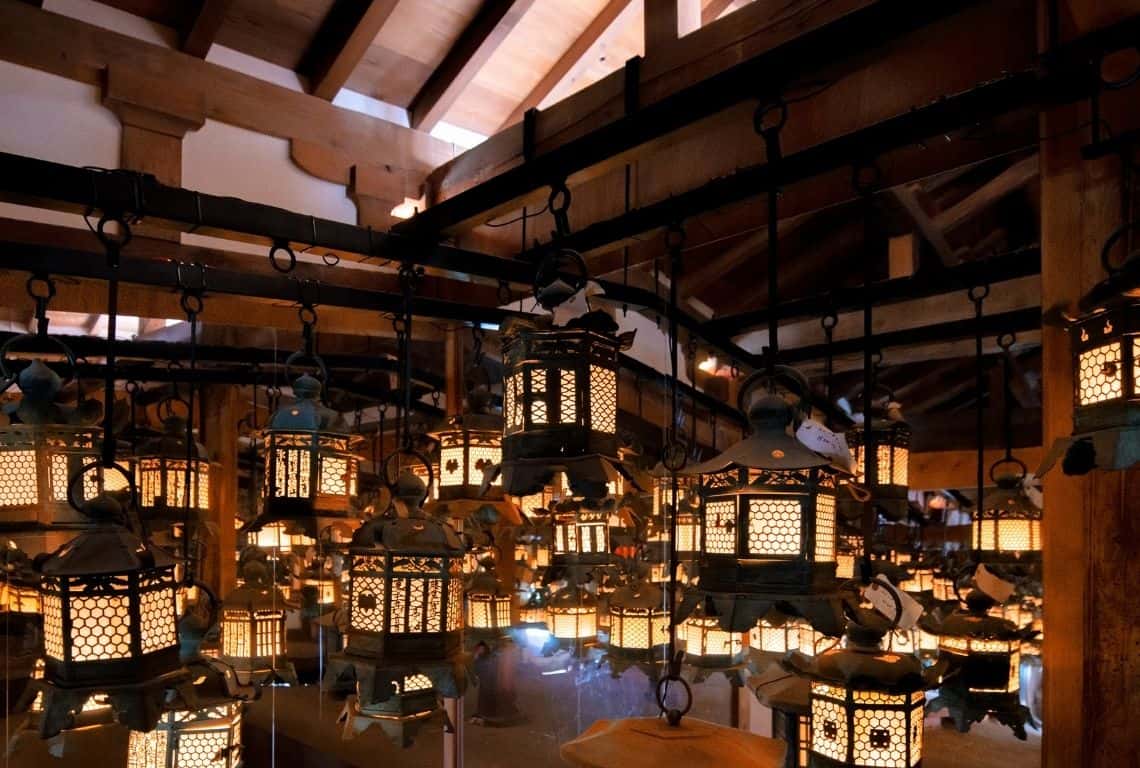
Kasuga Taisha is Nara’s most celebrated shrine / One Day in Nara
One Day in Nara
Where and What to Eat in Nara
There is an abundance of street food vendors selling all kinds of local delicacies. If you walk along Sanjodori, Higashimuki and Mochiidono Streets you will have plenty of choices.
During your Nara day trip, you need to try some local specialties. Here are my top two recommendations, you simply can’t miss:
- Kakinoha-zushi
Kakinoha-zushi is sushi wrapped in persimmon leaves. However, it is not the fresh fish that is being used, but rather one that has been cured. The typical types of fish that are used are salmon, mackerel, and trout.
Once the fish is cured, it is pressed into molded sushi rice (which has usually been mixed with vinegar.) and then, wrapped securely in a persimmon leaf. The little sushi bundles are usually packaged in wooden boxes and left for a few days to ferment.
My recommendation is to get a box ‘to go’ at Hiraso and have a picnic in the park if the weather is nice. Otherwise, you can dine in. Hiraso is a restaurant and a shop specializing in kakinoha-zushi. It has three locations in Nara. The one that is the easiest to find is located just outside the JR Nara Station.
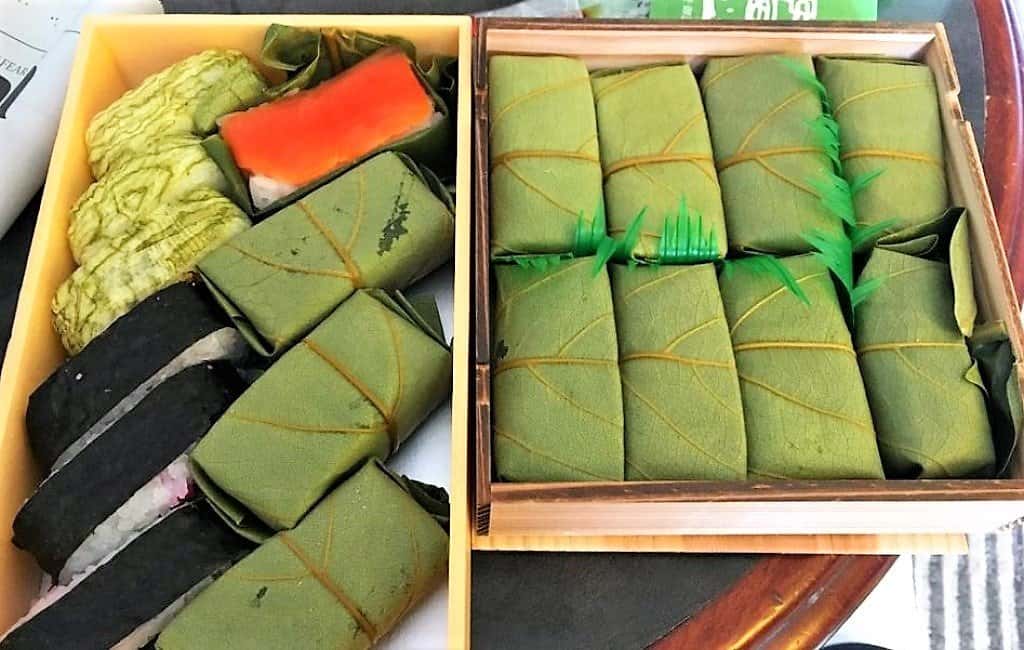
Kakinoha-zushi is sushi wrapped in persimmon leaves. However, it is not the fresh fish that is being used, but rather one that has been cured / One Day in Nara
One Day in Nara
- Mochi
I need to admit that the mochi in Nara was the best one I have ever had. First of all, you need to head to Nakatanidou. It is located on Hashimoto-cho Street, no more than a 5-minute walk from Kintetsu Nara Station. You will not miss it, because the mochi-pounding process takes place outside the shop and draws quite a crowd.
The high-speed mochi pounding, known as mochitsuki produces mochi that is soft and chewy.
Nakatanidou’s specialty is yomogi mochi. By the way, yomogi is a Japanese wild plant also known as mugwort. It gives mochi its natural green color and adds a refreshing taste. Once the gooey mochi mixture is produced, it is formed into oval cakes, filled with red bean paste, and lightly dusted with kinako (roasted soybean flour) before being served to customers. Each piece sells for 130 yen.
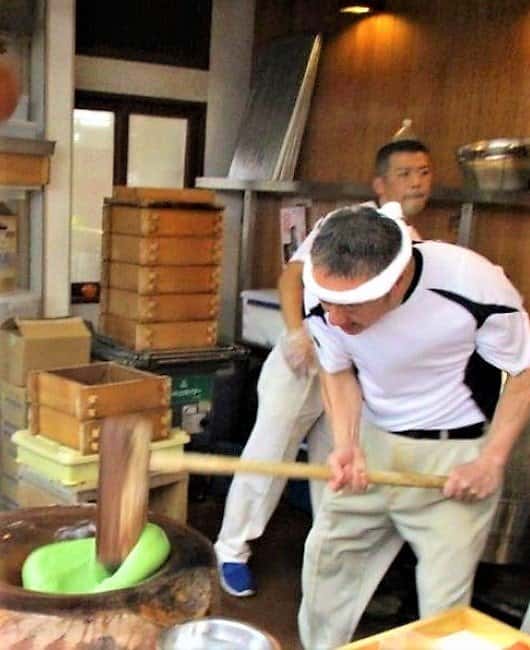
The high-speed mochi pounding, known as mochitsuki produces mochi that is soft and chewy / One Day in Nara
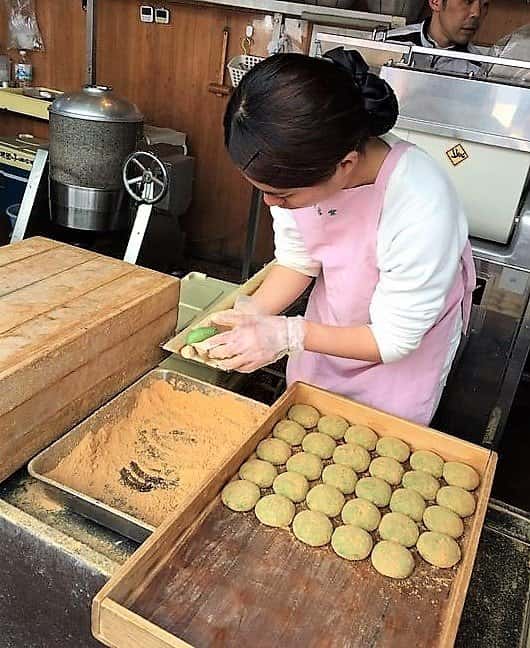
Once the gooey mochi mixture is produced, it is formed into oval cakes, filled with red bean paste, and lightly dusted with kinako (roasted soybean flour) before being served to customers / One Day in Nara
Intrepid Scout's Tips for One Day in Nara
- Nara is a perfect destination for a day trip from Kyoto or Osaka. And, it can be easily done!
- The best time to visit Nara is during spring. It looks absolutely spectacular with cherry blossoms. However, fall is just as stunning in Nara.
If you feel like it might be too difficult to navigate through Nara and get to all the attractions, then look into attending one of the half-day tours in Nara. My recommendation is to check out: The Essence of Nara Cultural Tour: Bid Buddha, Bambi, and Backstreets. You will get to visit temples, shrines, and traditional houses and feed the divine deer. Plus, the tour takes you through the backstreets and alleys of the merchant’s district, and you can try authentic street food.
Another great place that I am recommending that you visit is Arashiyama. Make sure to check out my post: 14 Unmissable Things to Do in Arashiyama, Kyoto
Here are Some More Useful Posts About Japan:
Stunning Kasuga Taisha Shrine in Nara (7 Best Things to See)
14 Amazing Things to Do in Arashiyama (Map+Useful Tips)
What to See at Nijo Castle in Kyoto (10 Top Things to Know)
Stunning Golden Pavilion in Kyoto (How to Visit and What to See)
Amazing Fushimi Inari Taisha in Kyoto (8 Things to Know Before You Visit)
First Visit to Kyoto – How to Visit and What to See (11 Things You Can’t Miss)
2 Days in Kyoto: The Perfect Kyoto Itinerary
10 Amazing Things to Do in Hiroshima on Your First Visit
Perfect Day Trip to Miyajima from Kyoto, Osaka, or Hiroshima (9 Things You Can’t Miis)
Did You Find One Day in Nara Useful?
Why Not Save One Day in Nara to Your Pinterest Board!
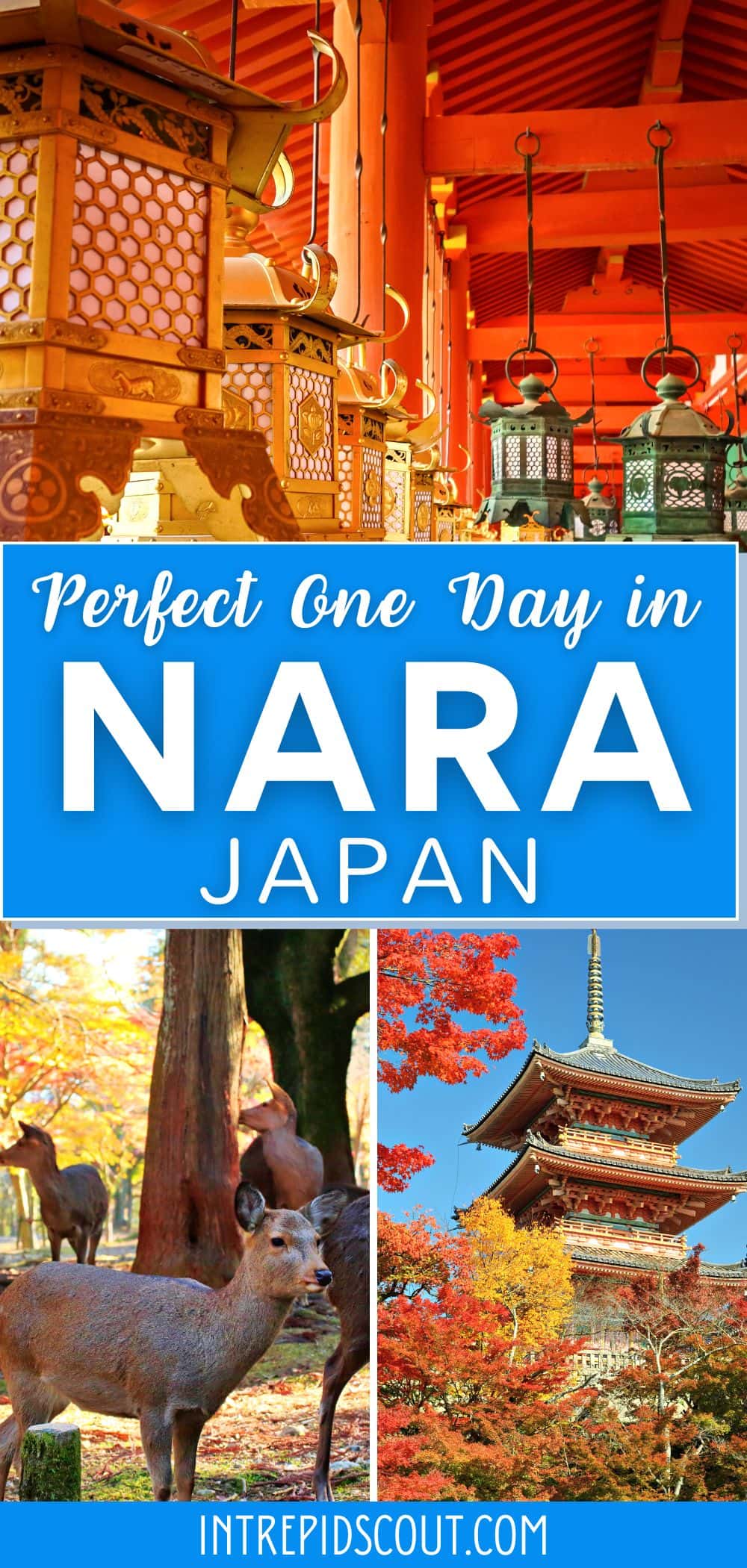
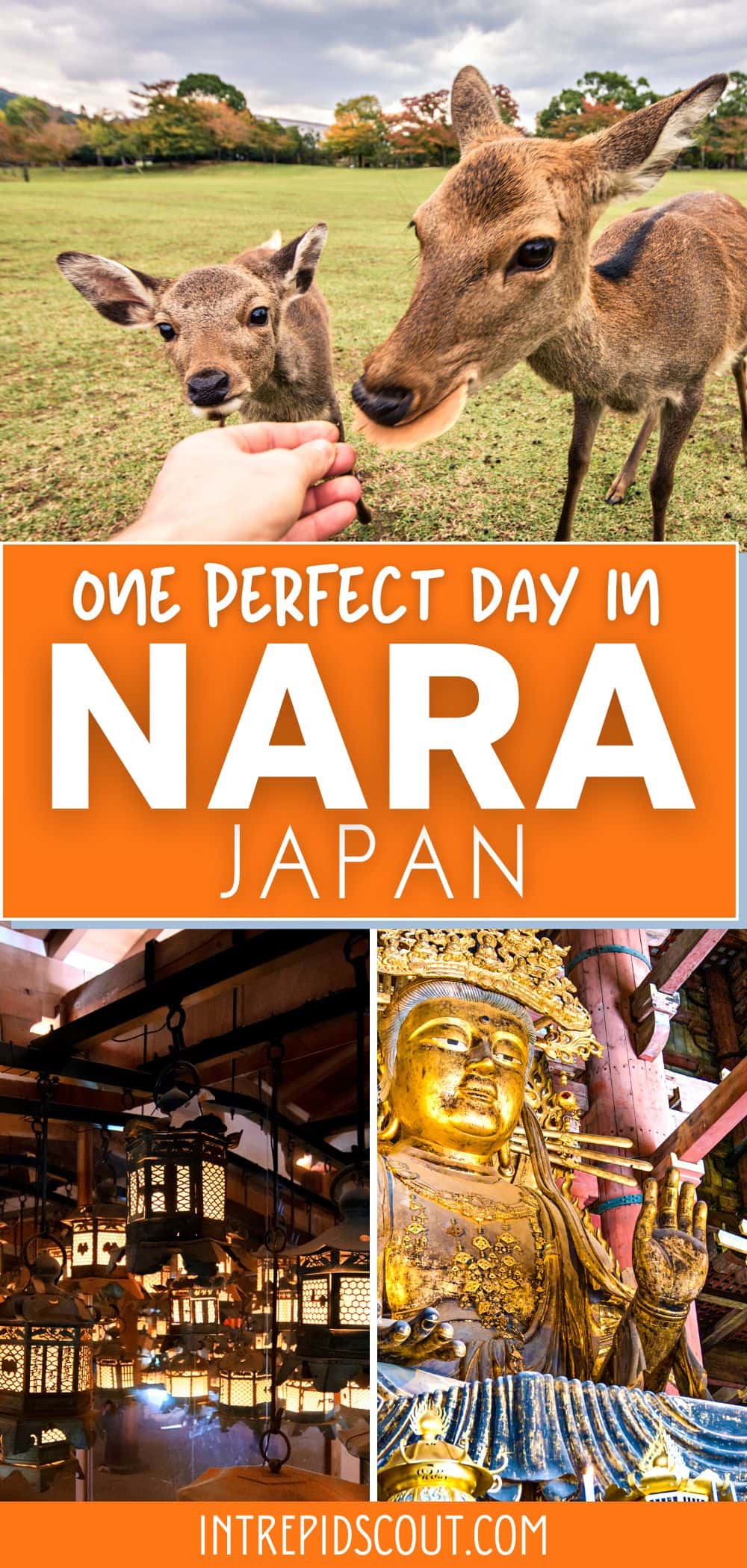
Now, It Is Your Turn, I Would Like to Hear Back from You!
Are you planning your trip to Nara?
Please let me know! Drop me a quick comment right below!
Click on any of the images below to get inspired and to help you with the planning process with your trip to Nara!
